Posted by Rick_Paine on 09-25-2002 01:29 PM:
Dyes and Ethnographic Value
By way of introduction--I am an anthropologist/archaeologist and have
been excavating in southeastern Turkey for the last couple of summers. While I
am there, I like to buy kilims and bags. The stuff I buy is mostly Kurdish
because I work and live with Kurds, have a deep affection for them, and think
their textile work is beautiful. I would not describe myself as a
collector--I'm in it for the experience and a lasting link to the Kurds. I know
virtually nothing about textiles (I probably like them because they are so
absent from the archaeological record).
I have been looking at old
TurkoTek salons for a month or so now, and have noted two very interesting
trends in many of your discussions: 1) a powerful desire to both understand,
and possess, 'ethnographic' pieces; and 2) the battle over dyes. I like the
definition of 'ethnographic' as made for one's own use--though it is hardly one
an ethnographer would identify with. I'll stick with it here.
It seems
to me that these two trends conflict. When a weaver chooses dyes for a piece
she plans to use herself (following above definition), she bases her choice on
several factors: local traditions, what is available, what is convenient, cost
(monetary cost or importantly, her time cost), and what she finds appealing (or
interesting). Synthetic dyes are likely to have been, at various times,
convenient, low cost, and appealing/interesting. When they were new, synthetic
dyes offered a variety and intensity of color unseen in natural dyes (other
salons have delved into the Kurds' particular affection for strong, saturated
colors). They also allow weavers to work in very pure, even color (I find it
hard to imaging the absence of abrash wasn't seen as pretty cool, at least for
a while). We should expect weavers to experiment and explore these new colors,
at least until hidden problems (fading) show themselves. The fruits of these
experiments should be of great interest to anyone looking at textiles from an
ethnographic perspective.
To eliminate pieces characterized by synthetic
dyes, either because of their long-term failure to hold color or because
contemporary tastes (either ours or those of contemporary weavers) run against
them, or our image of the 'primitive,' is to ignore a vast variety of
'ethnographic' pieces. One loses a very interesting period of development
(where isolated, sometimes nomadic weavers began to assimilate products from
the outside world). One also loses yet another of the weaving behaviors I see
constantly praised in these salons: the weaver's desire to experiment and
'play' rather than conforming to programmatic constraints so criticized in
textiles made for sale.
Rick Paine
Posted by Steve Price on
09-25-2002 02:02 PM:
Hi Rick,
First, welcome to our forums.
Your points are
very well taken. I think there are several reasons why many of the people who
hang out here are averse to things with synthetic dyes.
One reason is
not that the dyes can fade, but that they have already faded. I have one NW
Persian bagface with a palette of extremely faded synthetic dyes. The back, not
having been exposed to light, has more or less the original colors. I've shown
the piece to 50 to 100 noncollectors to illustrate the fading that happened to
early natural dyes. I've never had anyone think the front (faded) was more
attractive than the back. Maybe they were influenced by my opinion, but I don't
think so. So, since collectors are interested in aesthetics (many will say that
they're interested in nothing except aesthetics), the stuff with synthetics
loses points on this basis.
Another reason is that many collectors
simply prefer to collect antiques, as opposed to things that are not antiques.
Synthetic dyes pretty much eliminate early dates of manufacture. This is an
irrational reason, but collecting isn't a rational activity to begin with, so
collecting antiques isn't much more subject to this criticism than collecting
at all. Personally, I find it comforting to be around things that are older
than I am that don't look too bad. I don't predate synthetic dyes, but I can be
absolutely sure that things made before the introduction of synthetics are much
older than I am.
The rather exuberant orange used in many pieces around
the first quarter of the 20th century seems to many to be out of harmony with
the rest of the usual palette in which it is found. I guess that makes this an
aesthetic issue.
We can add things like snobbery and peer pressure to
the list.
On the bright side: we are rapidly approaching the point where
the "early synthetic period" (synthetics, but before the chrome dyes) will be
more than 100 years in the past. When those rugs become antiques, the
collectors of antiques will see them through different
eyes.
Incidentally, I was in southeastern Turkey for a week or so last
summer, and can easily understand your affection for the region and its
people.
I hope you'll continue to contribute your expertise to our
discussions.
Regards,
Steve Price
Posted by R. John
Howe on 09-25-2002 03:31 PM:
Mr. Paine -
You touch a chink in the "armour" of our collecting
standards.
Since the aesthetic standards we employ are seemingly largely
learned, they are a social product and manipulated by the current elite. Any
such phenomenon will have inconsistencies in it and points at which the
justifications offered will conflict. Sometimes it will become evident that
such standards cannot really be justified on the basis of the logics offered
for them. It can become irrational and, yes, we do sometimes bar ourselves
unnecessarily from pieces that we ought to consider more seriously, because we
find a few traces of a likely synthetic in them.
There does seem to be
some sense in which "old is better" is true, but there is no doubt that
meritorious weavings are likely made in every age.
Steve says, we value
the old, and that is true, but the presence of synthetics can actually be, and
this is increasing the case, an indicator of fair age. Not of the possiblility
that a given piece might have been made before 1850 but presence of an early
synthetic may let one estimate with fair accuracy that a piece was woven say
between 1875 and 1910.
At a rug club meeting recently I ran into a
person who owns a few rugs but who is actually a "print" collector. I quizzed
him about the standards he uses and especially about whether the presence of
synthetic dyes in a print lowers his interest in it at all. He said not; that
he is actually glad to find one since it functions as an age marker for him. I
asked him if synthetic dyes detracted from a prints aesthetic appeal and again
he said not. And print collectors are not immune to aesthetic judgments about
color.
At The Textile Museum recently some contemporary weavers were ooh
and aahing over some colors they were using that seemed of the "day-glo"
variety to me. Again, these are folks not untuned to aesthetics, including
color, and they looked at me blankly when I described why antique rug
collectors would find the colors they were admiring unsatisfactory.
And
we are inconsistent when we both admire the gentle pastels into which many
natural dyes fade with age and talk condescendingly about the "glare" of a
synthetic and then move to a dye that we think natural and admire its great
saturation and intensity.
So I would advise you to school yourself a
little. There is something to the standards into which we have been socialized.
But then you should buy what you like and what you think you could live with
and look at for a long time, even if you think such pieces have synthetic dyes
in them.
Regards,
R. John Howe
Posted by Filiberto
Boncompagni on 09-26-2002 10:50 AM:
Absolutely, Rick.
I have to say, though, that some open-minded,
ethnographically-oriented, narrow-budgeted
 collectors do not refrain from buying modern or not-so-old
textiles with synthetic dyes.
collectors do not refrain from buying modern or not-so-old
textiles with synthetic dyes.
Example:
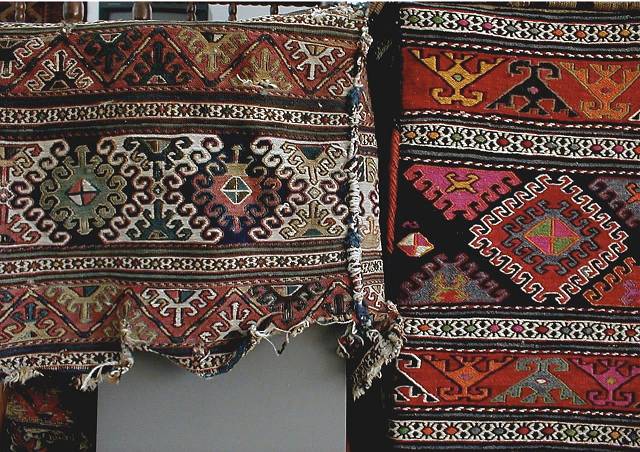
On the left an old tattered mafrash (probably a Shahsavan
from the Moghan region) good natural colors faded, but not terribly, with the
age. There is not a big difference in color between the external and the
internal side - this should be an indicator of natural dyes, I guess.
On the
right a modern mafrash, well done, nice wool, and, ugh you see those pink green
and orange?
(the gray strip under the old mafrash is a Kodak neutral test
card, with a 18% reflectance, that was supposed to help in calibrating the
picture’s colors).
None of them should be a serious
collector’s choice: the first is too ragged, the second for some of its
fluorescent dyes.
I liked the second anyway and I bought it.
It is so
ugly for you?
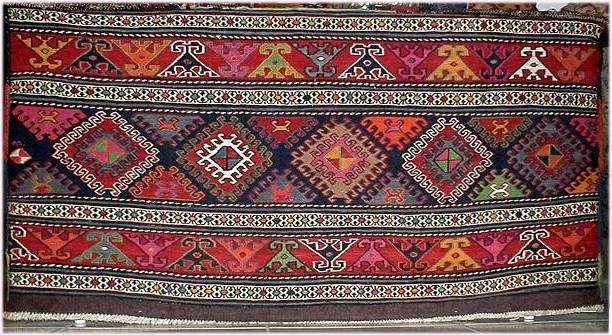
I suspect it is not as new at it seems. It
could be a dowry piece stored in a trunk and never used. The waver made it with
a good care. She used also some camel wool - at least it looks like camel
because it is softer, the fibers are longer and for its color. See
detail:
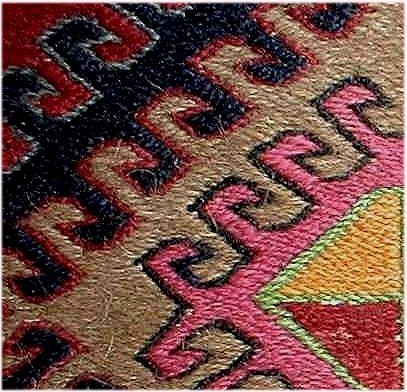
Then I bought the old one - I liked that too
in spite of its condition.
OK - In a better world I would have only one
mafrash: with the color and the age of the first and the perfect condition of
the second.
My only consolation: they both have - I believe - an
ethnographic value. And I like them both.
What do you
think?
Regards,
Filiberto
Posted by Steve Price on
09-26-2002 11:13 AM:
Hi Filiberto,
Forgetting about the aesthetics, I think these two
pieces show very nicely what I think of as the "tidying up" that seems to have
happened between the mid-to-late 19th and early-to-mid 20th centuries. The main
band, the two narrower bands, and the "crab"border of the younger one all
clearly have their roots in the tradition of the older one. But in the main
band and the two narrower bands the fluid drawing is replaced by a simpler,
more rectilinear style, and the negative space is much less a part of the
design.
I think having both is a good decision. It really makes each
one more interesting when you can compare them side by
side.
Regards,
Steve Price
Posted by Filiberto
Boncompagni on 09-26-2002 11:40 AM:
Hi Steve,
Yes, another point in having them both was the "air of
family" between them. Like the modern mafrash was woven by a granddaughter of
the weaver of the old one. Which, broadly (anthropologically) speaking, is
correct.
Regards,
Filiberto
Posted by Rick_Paine on
09-26-2002 12:52 PM:
First, thank you for the kind welcome and the very interesting
replies.
My post was essentially about the contrast between cultural
interest (ethnographic interest to an ethnographer) and aesthetic interest. I
think both are absolutely wonderful perspectives to approach textiles (or just
about anything else). I did not intend to denigrate either collectors' well
educated (I have been thrilled by the knowledge that comes out in these
salons--I'm learning by the day) senses of textile quality, or an approach to
collecting based on aesthetics. My principal aim was to suggest that many
'ethnographic' pieces have interest that goes beyond pure aesthetics.
Clearly, the two are not mutually exclusive. One big reason I think I
am attracted to textiles is the way they blend utilitarian forms with art. When
I go looking at kilims (I can't afford to look at knotted rugs. If they are
interesting, they are beyond reach), or bags, I am usually attracted to them by
their beauty. Aesthetic appeal (for me) follows my socio/cultural/temporal
perspective. I am a middle aged, classically liberal, New England male from the
academic class. As such, I tend to be attracted by the same softened, pure
colors (likely natural dyes most of the time, though as I have said, I'm really
not qualified to say) that I suspect most collectors out there prefer, along
with the strong geometric designs often associated with 'tribal' peoples. I
have only once bought a textile that drifts too far from contemporary concepts
of beauty (see below).
However, I am also an anthropologist (this is
more relevant here as an insight into my personality than an indicator of
professional affiliation), which means I get pulled in different ways too. The
'ethnographic factor' can occasionally pull me in even if a piece violates
contemporary aesthetic tastes. Last summer I bought a piece my companions found
genuinely offensive. It's a Kurdish Baddanni or Filikli. It's not as nice, but
looks a lot like one pictured in Daniel Deschuyteneer's salon on Kurdish
weavings (which I enjoyed thoroughly--wish I'd been aware of TurkoTek when it
was active). It has wild, synthetic colors (powerful oranges, sadly faded
purples, electric pinks--a member of my project described it as the shag rug
from hell). I love it. I think it looks like it's on fire. However, if it did
not appeal to me from an ethnographic perspective (I thought I knew its use
before reading another salon, which raised alternative possibilities), I
probably would never have looked at it long enough to appreciate its strange
beauty. Understanding a piece's use and cultural context adds enormously (for
me) to a beautiful piece's appeal, and can be enough to get me to part with a
few million Turkish Lira for a less attractive one.
One reason I would
like to see collectors take the ethnographic side seriously is so textiles that
have cultural interest wind up in places where they have a chance to be
preserved. These objects preserve behavior that is currently disappearing, not
just from the contemporary world, but from memory (as elderly people who have
lived a nomadic lifestyle die off). Ethnographic textiles can tell us about
aspects of daily life. They can also tell us about evolving connections to the
larger world, and evolving senses of group identity, and aesthetics. That makes
pieces 'made for one's own use' intrinsically fascinating, regardless of their
current aesthetic appeal. Because some of these pieces are not aesthetically
exciting (or maybe too exciting), at least by 21st-century western collector
standards, they are endangered (does that make them intrinsically
collectible?).
Thank you again for the great conversation. Guess maybe
I'll go register.
Posted by Rick_Paine on 09-26-2002 01:11 PM:
I think both of Filiberto's bags are wonderful. The bright one reflects
the color sense of its maker, which I find fascinating.
The colors
remind me of rugs I've noticed among contemporary Kurds in Turkey. Based on bad
sampling (the handful of houses I have been invited into and rugs hung over
balconies to dry), the big room rug of choice today is a machine-made 'Persian'
with a big central medallion. This is not so enlightening so far, you can see
them in homes all over America too. The difference is the field color around
the medallion. The color of choice--a radiant magenta (bright aquamarine is
also popular). You see these rugs everywhere. I suspect the same sense of color
went into Filiberto's bag.
Woven plastic mats with big geometric
patterns are pretty prevalent too.
--Rick
Posted by Chuck
Wagner on 09-26-2002 06:03 PM:
Arrgghh... ANOTHER century to deal with...
Hi All,
As many of you have noted previously, I'm another who is
undeterred by the presence of synthetic dyes in woven goods.
Our (my
wife generally has a say in what gets bought) criteria for acquistions is not
rigid or closely focused, as our tastes (and our handicraft collection) is
eclectic.
Thus, when we encounter pieces that appear to have been made
for personal use (ethnographic pieces, as Rick mentions) we are quite flexible
with regard to their attributes. Colors and/or designs that clash with our
tastes rarely make it to the counter. The same is true with shoddy workmanship,
or pieces suspected to have 10,000 clones spread around the world.
But
knowing that a lot of folks in the weaving cultures live pretty close to the
edge, economically, we'll make exceptions for pieces that appear to be genuine
artifacts of a disappearing lifestyle.
Here are two examples, both
containing a dye that (to my uncertain eye) appears to be fuchsine. I'm pretty
sure they're 5th or 6th quarter 19th century.
The first, I think, is
from north central Afghanistan, probably Ghormaj. A salt bag that has certainly
seen better days but also has the distinct look and feel of something used for
decades. The wool feels like it's still attached to the sheep.
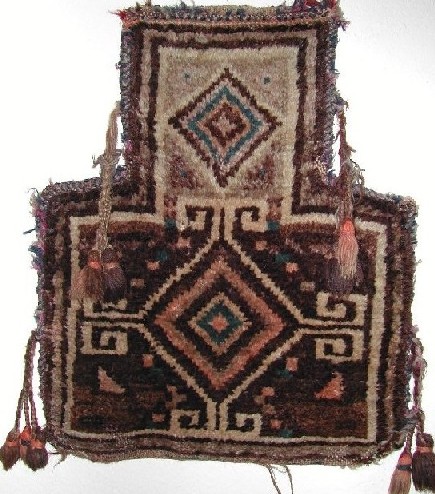
The closeup shows remnants of the original purple color.
The inside is in good shape and shows no evidence of bleeding due to a harsh
wash.
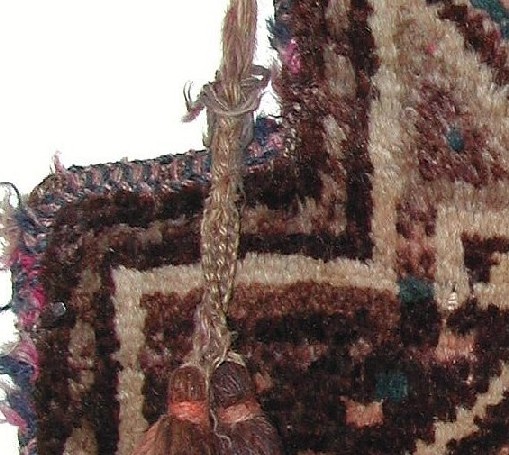
The other piece is a small bag, bigger than a
chanteh but smaller than a khorjin. When I first saw it I thought it was
Chinese because of the sheen on the wool, the velvety texture, and the odd
color scheme.
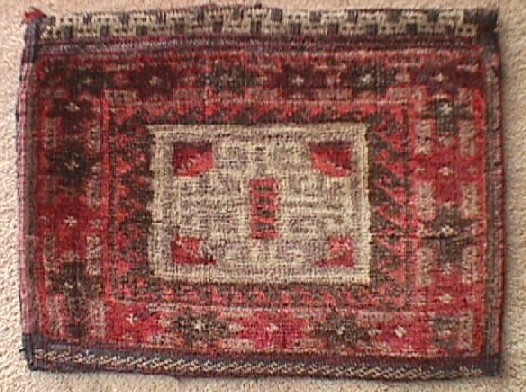
Then I looked inside...
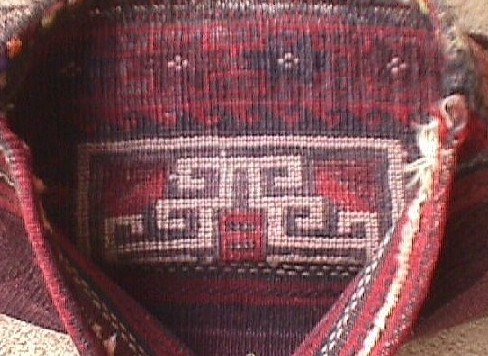
We don't have too many pieces like these. But then, as
most of you know, they are uncommon (which is different from rare and valuable
 ) in any market. Their presence is evidence that things have gone so badly in
Afghanistan that the last of the utilitarian goods are going on the market to
raise cash.
) in any market. Their presence is evidence that things have gone so badly in
Afghanistan that the last of the utilitarian goods are going on the market to
raise cash.
The 20th century is one where commercialism and synthetic
dyes dominated the weaving world. Yet nomads still wandered the steppes and
mountains, and poor settled people still made goods for their own use.
Ethnographic goods were still created.
As Steve points out, products
with synthetics are aging into the antique period now, and may gain additional
audience as a result. We should expect more and more queries from people who
seek knowledgable commentary on pieces from the "post-natural-dye" period.
With sufficient study, I suspect we will attain some level of
satisfaction with our ability to establish dating and attribution criteria for
some groups of 20th century rugs. As the weaving cultures comingled and
traditional classification techniques (design, structure) became less useful,
were not some other patterns beginning to develop ?
This will be the
challenge of antique weavings from the 20th century. We should hone our minds
now, while the weavers are still alive to talk to, so when the questions start
coming we have some ideas.
Let's assign a grad
student...
Regards,
Chuck
__________________
Chuck Wagner
Posted by David R.E. Hunt on 09-27-2002 10:18 PM:
Apples or Oranges
Dear Rick and All- This aversion to artificial dyes and latter weaving
is understandable, but I think it is important to keep things in perspective,
so as to neither confuse apples with oranges or misconstrue the proverbial tree
for the forest. While most would agree that the natural dyes of old yielded the
best colors and in many respects differientiate the truly old or early,
especially among Turkmen weaving, from latter antique or modern weaving,I think
that it is important to remember that these early Turkmen weavings are both
quite rare and quite expensive and as such constitute a smaller percentage of
all rugs and are not representative of the body of Turkmen weaving as a whole.
So when we try to compare an early 19th century Tekke to a late 19th century
tekke we are confusing categories, comparing apples to oranges. Also, I believe
that latter weavings have much to commend themselves, and are most worthy of
collecting, even if for no other reason that they represent a continum. In as
far as these florescent dyes are concerned, it is my understanding that people
in the rug producing portions of the world like these colors, and that is why
they use them. At one time in the not too distant past here in the west,
florescent colors were considered stylish, and if you like them, by all means
collect them. Collect whatever category you like, be it pre 1860 natural dye,
enhnographic, or any number of variations,find the best examples you can and
most of all collect for yourself. Ultimately you are your own authority.-
Dave
Posted by Michael Wendorf on 09-29-2002 11:37 PM:
apples and oranges
Greetings:
It is exciting to hear from a new contributor who is
or has been working and living among the Kurds in SE Anatolia.
While i
agree that anyone can collect anything they find to be compelling or of
interest, I have to wonder about the ethnographic interest as well as continum
that David mentions in connection with weavings with synthetic dyes. What
exactly is it that makes these weavings ethnographically significant or part of
a continum? If Kurdish weavers, by way of example, wove with natural dyes from
local sources and from local recipes for centuries or even thousands of years
only to have these dyes and recipes lost as they were quickly replaced by cheap
synthetic dyes from European companies what is it these weavings represent? The
destruction/loss of a dye tradition? The loss of a way of life? Not much to
celebrate it seems to me - and that quite aside from any aesthetic issue at
all.
Regards, Michael
Posted by R. John Howe on 09-30-2002
06:50 AM:
Michael -
One would certainly have to agree that there is
ethnographic loss when European dyes are substituted for those produced
traditionally within the particular rug weaving community
(Although
note that we seem to acknowledge at the beginning that many rugs we would
consider still to have ethnographic significance were not necessarily woven
from the wools of the weaver's own flocks or dyed by the weaver's own hand and
that likely did not go on "from antiquity," so there is some likely change from
earlier ages of the tradition reflected even in this beginning position. One
might hold that the fact that the dyes came from local Jewish dyers rather than
from European firms is only a matter of distance, that the local Jews were
outside the Kurdish tradition too).
But would you argue that the entire
ethnographic significance of the rugs we collect resides in the character of
the dyes alone?
It seem to me that the enthographic significance of
something is likely based on multiple indicators. Some of these might be the
quality and character of the weaving, the designs, some indication perhaps that
an item was used, etc.
How would you evaluate a piece that is made
using "weftless sumak" but that has some recognizable traces of synthetic dyes,
some goat hair and some places where undyed wool has been used?
I have a
Tekke torba that seems likely to me to have been woven mostly with synthetic
dyes about 1910. It may also have been chemically washed. To make my confession
complete, it was an early purchase, and I bought it because a I liked its
"coppery" color.
 But the technical quality of the weaving and the drawing on this piece are both
admirable, it has a rather unusual gul device, and there is some organic matter
in the bottom of it (it is complete with its back) that makes me think it was
used. This is not a piece over which advanced collectors would salivate but has
it lost all of its ethnographic significance?
But the technical quality of the weaving and the drawing on this piece are both
admirable, it has a rather unusual gul device, and there is some organic matter
in the bottom of it (it is complete with its back) that makes me think it was
used. This is not a piece over which advanced collectors would salivate but has
it lost all of its ethnographic significance?
Is the ethnographic
significance of a piece utterly sundered by the discovery that it has some
synthetic dyes in it?
Regards,
R. John Howe
Posted by
Steve Price on 09-30-2002 08:17 AM:
Hi John,
I would go even further than you along this line. Tribal
and village weavers hopped on synthetic dyes like chickens on June bugs. They
did so because they liked the colors and couldn't get them from natural dyes.
That is, the synthetic dyes (at least, until they faded) represented their
personal preferences. They still do.
I don't think synthetic dyes became
cheap to these people until some time later. When that happened, of course, low
cost became another factor.
Regards,
Steve Price
Posted by Filiberto Boncompagni on 09-30-2002 11:25 AM:
To dye or not to dye
Hi Steve,
Right, "they liked some synthetic colors and they
couldn't get them from natural dyes."
And there’s the rub. "They still
do."
Remember those rugs from Salon 64?
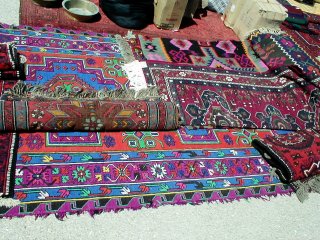
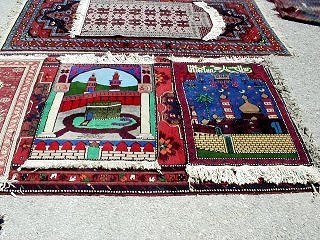
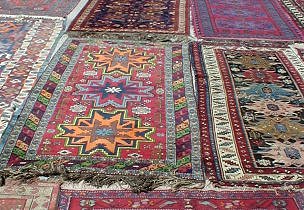
Yet, there are collectors who
reject some textiles not for the ugly colors (see above) but only under
SUSPICION that some dyes could be synthetic.
Regards,
Filiberto
Posted by Steve Price on 09-30-2002 11:44 AM:
Hi Filiberto,
The aesthetics of the colors aren't the whole
story. A lot of folks want antiques, and only antiques. Besides, nobody wants
to overpay, and an antique has a higher value than something too young to be an
antique.
When someone says that he suspects that a dye is synthetic,
his real concern is that the piece isn't antique. He may not want it for that
reason, and he surely doesn't want to pay the price of an antique to get
it.
Regards,
Steve Price
Posted by Chuck Wagner on
09-30-2002 01:49 PM:
You Guyz Are Full Of Surprises
Steve, et all:
...Good. Now we're back to my last point: Now
that the world of synthetic-dyed rugs is creeping into the antique zone, what
(if anything) should Turkotekkes do to maintain the high standard of Guru-ocity
that has been the tradition here, when dealing with 20th century pieces
?
This group loves a challenge, and besides, there ARE some real works
of novel, unique art out there in syntheticville (in both the aesthetic and
ethnographic categories). Is an ordered approach of any value, and worth the
effort ? Should we develop a vetted image gallery for use in establishing age
related trends in colors, design, materials, etc. Do Steve and Filiberto have
endless time to spend looking after such a thing ?
That kind of
stuff...
So, I think it's worthy of some discussion, possibly in another
thread. But if I'm the only one that thinks so, I'll just pull the handle and
not worry about it 
Regards, Chuck
p.s. I can't believe ONE of you hasn't given me
some guff over that beat up old salt bag yet. You all must be tired...
__________________
Chuck Wagner
Posted by Steve Price on 09-30-2002 02:20 PM:
Hi Chuck,
John Howe did a Salon not terribly long ago on the
subject of what collectors will be collecting 100 years from now. That's sort
of along the lines that you suggest. If you'd like to work up an essay more
directly in keeping with your idea, I'd be happy to run it.
I think the
salt bag is OK, but not to die for.
Regards,
Steve Price
Posted by Filiberto Boncompagni on 10-01-2002 09:52 AM:
Hi Chuck,
Why don’t you give it a try?
I’d like also
to see some of Rick’s Kurdish stuff.
Regards,
Filiberto
Posted by Michael Bischof on 10-01-2002 04:32 PM:
another approach
Dear all,
this is an ever lasting topic - and I like it like that
!
Chuck Wagner: here comes the guff. I find the salt bag u g l y - and
the two pieces that Filiberto Boncompagni shows do not convince me at all. With
his estimation of the first piece I agree.May be a proper decent wash to revive
the colour could improve it a bit ? Anyway, not the best of its type. The
second one I do not like. Better: I cannot like it as it looks
"wrong".
2 years before we had a fashion here: traditional "geometric"
carpet and kilim motives on pullovers ( machine knit, synthetic dyes, combined
for a pastel elegant European indoor look) . It really hurted my eyes: it
looked "wrong". The motives in a way do not function with these dyes. May be as
they arose from a kind of co-evolution with strong natural dyes ?
This
tradition is at least 4000 years old ( I speak of weaving using dyed fibers)
and within this time span a sustainable result evolved: harmonious combinations
of upmost saturated natural dyes, applied in tricky and lengthy processses (
that did not harm the fiber integrity). This can be seen best in not (!)
patinated (light-oxidized, damaged) pieces but in mint condition though their
number is indeed very small. " we both admire the gentle pastels into which
many natural dyes fade with age" ( R. John Howe) is a description of the
attitude that the majority of collectors hold. But in science and art it is not
the majority that counts. Great dyes do not (easily) tend to develop gentle
pastels. Look at some great early 14.-17. century fragments - but, please, to
the wool inside the pile, not at the surface (though many of them even there
have an intensity that is breath-taking).
The more "pure" the natural
dye is the more costly it is to make it, leaving the necessary know how aside.
With natural dyes one can make even stronger pink colours than the piece of
Filiberto displays - but such a dye this weaver could not have afforded, at
least not to use it in these high amounts. Some jewel like tiny spots,
highlights....
This is an aesthetic approach. It has nothing (!!!) to do
with age ! Great creativity was extreme rare in old days and today ... only a
fool would reject a splendid weave because it is new. 200 years before people
used better dyes for the simple fact that the quicker, lower quality
substitutes were not available, yet. Please do not forget that the essence of
industry is to substitute human labour - at the expense of quality in most
cases, at least with textiles.
"Ethnographic" value: if it is no weak
excuse for aesthetically wrong selections there must be a "story", a background
that proves the significance of a particular "ethnographic" textile ( no matter
whether there are synthetic dyes in it). This story, of course, should be so
that it can be checked in order to avoid
tapetological fairy
tales...
Michael Bischof
Posted by Rick Paine on 10-01-2002
07:39 PM:
Two quick points:
1: One's individual aesthetic taste is
important, and it is an appropriate (probably the best) basis for collecting.
It is also highly culture specific. One learns to appreciate colors, (or
musical styles, or the shapes of the opposite sex) favored by their 'peers.'
This sense serves as, among other things, a means of identifying other members
of the 'in' group ('us' from 'them'). It lets one know who is an acceptable
friend, ally, or mate.
Let me give an example from an utterly unrelated
area. Classic Maya nobles had a rather different idea of beauty than
21st-century Euro-Americans. The found an elongated skull and receding forehead
ideal (all with hand tools!). They also filed their teeth into different shapes
and inlayed them with green stone. Having the right forehead was as clear a
status marker as knowing which fork to use has been more recently. When I tell
my students about Maya fashion trends, I invariably get audible groans from the
room. My reply is this: we live in a society where people surgically implant
sacks of jelly in their breasts and have their teeth filed to nubs and replaced
with ceramics, wear high-healed shoes that destroy their backs, and where their
parents chemically curled their hair (how you feel about any of these things
probably says a lot about your specific social group too). Our fashions would
probably be as repulsive to the average Maya as filed teeth are to us. The
point is if you JUDGE other culture's aesthetics (what you choose to put in
your own home is a separate issue), you have missed some important
points.
2: Cultures are dynamic entities. Styles change when new groups
or ideas pop up, or when individuals defy established norms and experiment.
They also change with technology. The process of change, whether caused by
social change, technical change, or something else, is not only normal, but
absolutely fascinating to many of us. To suggest that a culture (or an art
style) has somehow devolved because it has adopted technology or patterns that
do not appeal to US (this has an incredibly long tradition in Art History) is
horribly ethnocentric.
By all means collect what you like. If I can
borrow a digital camera and figure out how to post some pictures, we can have
some fun critiquing what I like (those hoping for a collection dominated by
shocking pinks will be disappointed). Personal choice is fair game--and fun.
But, be careful about blanket statements about whether other cultures are
degenerated because they chose a technology, or a new palate of colors they saw
as a benefit.
I have to go find a pigeon so I can post this.
Posted by Michael Bischof on 10-02-2002 02:54 AM:
Dear all, dear Rick Paine,
thanks a lot for your welcome
statement !
To warn against ethnocentric remarks is important, indeed.
But the adressates of such warnings are not people that uphold natural dyes -
the ethnocentric crowd is made up from those who come with claims like "this is
art ... because it has some impact on me!" and who therefore try to put down
all efforts to determine the significance of a certain textile (piece of art)
within its original context ( as far as we can research it ).
To warn
me against it is like taking owls to Athens. I lived from 1992 - 1998 in the
Türkmen Evleri Mahalle in Karaman and work together with weavers in the
Karaman/Taskale area till today. So I could do more than sitting in Germany (or
America) at my PC and start to speculate whether and why weavers in the remote
Near East would like natural dyes or synthetic ones. We could test
it!
The result is crystal clear: - where they have a chance of selection
they prefer natural dyes (in case these look like what they have in mind: a
real red, no "production red" (1), a splendid real violet from madder only,
blue Indigo hues that do not inflame your skin ... as mentioned before: in
Karaman the ladies in the neighbourhood constantly come to the master weaver
with whom we work together, Susan Yalcin, to catch a bit of strong natural dyes
and knit it into pullovers. Not into the cheap commercial rugs they weave for
some Istanbul firms and not into their own little rugs - as they are too
valuable for that, today.
And: the yarns should be clean, you hands
should not appear stained in the evening. This is the reason why today local
weavers reject (if they can) the contemporary offers of Turkish carpet
producers who use these "amateur" natural dyes. - in old days and today the
weavers/knitters had no access to the most important dyes. But in old days
there was no alternative to natural dyes - today there are a lot, and these are
cheaper! - one can combine excellent natural dyes in whatever crazy
combinations in case they have, more or less, the same grade of saturation -
with harmonious results. Of course it is possible to make ugly weaves with the
best available natural dyes, e.g. if you apply too many without creating a
recognizable image. But this is difficult - with synthetic dyes it is easy to
create ugly results, as the given pictures show.
If you are not
convinced: - look at the shocking pictures Filiberto Boncampagni contributed.
And then imagine the same weaves done with natural dyes, but imagine pieces in
mint condition! - you gave a good example: a baddani with shocking synthetic
dyes. Now imagine one would do such a thing, using silky Mohair and natural
dyes, expertedly done in order to come close to the overall look of your
baddani. This is no theory, please. It could be done! Take my words as a kind
of bet. But then the price would be like with an antique piece. The look will
be very different, though.
Of course culture is and has always been
changing. To follow it is a fascinating field! But when you change basic
technologies there is always the risk of mishappenings: evolution produces also
a lot of "trial-and-error"-results that do not survive, that are not successful
... as long as it takes to achieve a successful new identity on the basis of
that new technology. My thesis is that we should judge these synthetic dyes as
such mishappenings - and, in certain, well researched ( !) cases, may estimate
certain exception for their creativity, other aspects of a special meaning ....
What a certain individual collects or not will, of course, remain his
private obession and right. I like the idea of "good taste" - as long as it is
not dictatorship. Personally I own some ugly artifacts because they remember me
of certain situations that I like to remember. But, damned, that does not make
them beautiful.
Michael Bischof
(1) Production red ( "imalat
kirmizi" ) is an insiders term of carpet producing people in Turkey. It
describes the result of what you get if you follow some Western hobby dyeing
recipes with madder plus try to save money by using the lowest possible amount
of expensive madder when doing it. A kind of matt, brick-"reddish"-"brownish"
something ... by light oxidation it changes in short time to a clearer red but
on the expense that roughly 30-40% of the dye lake amount is killed and the
fiber looks spotty, then, as this process is uneven. To overcome this problem
most guys add some synthetic red dyes on top of it. It is called
"köklü" boya then - what means: the dye contains madder. "Kök
boya" would mean: entirely from madder with no (!) synthetic additions. This is
an old habit: when the newly found azo dyes were applied in the Orient at the
beginning people liked very much the pure, "shocking" impact they had. But they
faded quick. It did not take more than 10-15 years to have a more rational
method evolved: to drop the dye costs by using only a small portion of madder
in a quick (!) process and then top the unsatisfactory result with some azo.
This we often find in end of 19th century woven Caucasians and Turcomans. Rick,
sorry, this is second ranked: because it looks so!
Posted by Chuck
Wagner on 10-02-2002 05:43 AM:
Michael,
Your comments don't address the ugly rugs made with
natural dyes, (and there are LOTS of them) and how it is that they can be made
with natural dyes and STILL be ugly.
And, you seem to be missing Rick's
initial point, which was that when collecting pieces from a cultural
perspective rather than a narrowly focused aesthetic perspective, the natural
vs. synthetic dye argument has no meaning. It becomes a question of practical
use as an indicator of age and cultural origin.
And then there's
Filiberto's point, which was: Maybe the weavers use these colors because they
LIKE them. Certainly, there are occasions where weaving is done under contract,
and the weaver has no control over materials. But the Qashqai CHOOSE to weave
with garish colors. I do not think it's because they've been watching too much
MTV. It would be simple to use sombre synthetics, as the Baluchis do. The
bright colors are used because they LIKE them.
This is not to say your
thoughts are wrong. Your own experiences clearly shape your opinions. And,
every collector sets their own standards.
Last, I agree with you
regarding the aesthtic appeal of the salt bag. But I didn't buy it because I
thought it was pretty. I WOULD like to know if anyone agrees that the purple is
in fact fuchsine because, if so, it puts an age bracket on the article in
question.
Regards,
Chuck
__________________
Chuck Wagner
Posted by Michael Bischof on 10-02-2002 10:38 AM:
ugly rugs
Hi everybody, hi Chuck,
well, my language might not be precise
enough: I mentioned the possibility to create ugly rugs from splendid natural
dyes as well. That it happens is quite unlikely, but possible, yes. To create
handsome, not to say beautiful, rugs with synthetic dyes is extremely
difficult. One must (!) use other motives then. The traditional ones do not
"work" as the examples show.
Cultural perspective: always welcome! But
this one would like to see in a way that can be checked and discussed, not as
an empty claim. Sounds nice: but then you should not just show or mention the
piece. You must add the background story. Because, on its own, the piece does
not deserve attention.
Filiberto is right: in these +/- 4000 years
weavers learned that it is a kind of hard fight to release pure, shiny dyes
from natural sources. The more pure the harder it was - and therefore more
expensive. As people always fight (or prefer) what they do not have such a dye
in pre-industrial times were most likely visual status symbols. But when their
cheap substitute became plenty the uncontrolled use of it killed the aesthetics
...
But again: a striking pink made in a special way, let us assume from
Cochenille, is light years away from these cheap pinks, visually and in its
performance! So to use it would give a different result. Of course how to use
it needs certain self-discipline. But this one needs in each art. Who cannot
master it ... from the distance I must say what I have said when living and
working at the spot: "authentic" is not automatically the same as "splendid" or
"successful". Gashgai women are not the only ones that produce Kitsch although
they are, technically, master weavers. In Karaman I saw shocking examples of
that as well. In case such people lose against an alien culture, accept its
predominance and try to copy elements of it - why should we admire the results
of that attitude? To admire the physical beauty of those girls seems to be a
better alternative - for me at least.
I do not dare to comment on the
fuchsine problem from this picture. The bag looks like a typical "semi-antique"
piece: 20-80 years old, done with synthetic dyes, faded in use ... it does not
smell that one would find fuchsine in it. Nevertheless: if the situation when
you got it was such that you would like to remember it - fine.
Yes, and
here is the problem. In my opinion we discuss such things here in order to
develop standards, measures, etc. Pieces with synthetic dyes do not contribute
to that - unless they are embedded in a "cultural perspective". But again: this
must be displayed then!
2 years ago there was a well announced
exhibition of yastiks in Northern Germany. Some 20 or so pieces. Only 2-3 were
natural dyes, but they were not top pieces. All pieces had been bought in the
trade, in Turkey in most cases. Their real origin, everything else .... was
unclear. Except some that were, with precautions, defined by some of the
viewers. Where, please , is the "cultural perspective" here?
The
synthetic dyes made the pieces aesthetically uninteresting. Such things might
be valuable - together with a proper, well documented background story. But by
occasional buying in touristic carpet shops one cannot accumulate it. What is
left then?
By the way: it was no idea to drive 400 km to see it. If I
would have known ... or, better, if the unlucky collector would have followed
the advice of Michael Franses (like: study the subject as well as you can and
then buy the best that you can afford) - then I would have in my brain 2-3
great yastiks that since then I wouldn't have forgotten.
If Rick Paine
would use his free time while being there, learn the local language, group some
co-workers (some ladies must be in the group! Turkologists as well, for the
important details of local language) and would start field studies - yes, then
there would be a "cultural perspective". But the measures should not be lower!
In this way one could well collect material for articles, for an exhibition.
But this would not be related to art. A proper title would rather be "Status of
the local cottage industry of ..... at the end of the 20th century". The bulk
of Caucasian weaves from the second half of the 19th century, by the way, would
fall into this category as well.
"And, every collector sets their own
standards." What someone chooses to collect is, of course, his own choice. What
he claims it to be is not his choice - it can be discussed and, well, be
rejected.
Michael Bischof
Posted by Michael Bischof on
10-02-2002 12:31 PM:
Hi Chuck,
sorry, I did not put enough attention on your first
sentence
quote:
Your comments don't address the ugly rugs made with
natural dyes, (and there are LOTS of them) and how it is that they can be made
with natural dyes and STILL be ugly.
as I see now.
Postponed, not forgotten!
Please be more specific: what "natural dyes" do
you mean ?
Do you mean
"natural dyes" as to be seen in todays commercial fashion of Near
Eastern carpet producers?
- Or do you mean "natural dyes" (sensu strictu) in truely antique
pieces or done today with methods equivalent or even superior to those ?
This makes a big difference. Let me start with what one can learn
from old pieces. All early Turcomans, for example, have ultimate saturated dyes
of varying degrees of "purity". In addition the very early ones display a more
free ( but still very disciplined ) use of them. Same with Balouch. The latter
prefer such dark combinations that they should be viewed in bright sunlight !
Otherwise they do not "work".
If you compare now late pieces you will see,
I guess, that these in most cases have less saturated, but often ( with the
help of azo-topping) more "pure" dyes. As the synthetics fade what is left is -
I speak of truely antique, but late pieces here ! - a disappointing "flat"
appearance.
Now imagine you take a little thing, e.g. an 18th century
Salor or Arabatchi cuval, to a carpet shop and put it on top of
modern "Turcomans" or "Caucasians" from Pakistan
- modern kilims from Iran or Turkey
- late 19th century Turcomans or Caucasians (the usual auction stuff,
to sum it up)
I think you will immediately get my point. With the cottage
industry of today we have another problem. Tradition is the source for boring
repetitions - but at the same time, as people tend to repeat "successful"
combinations, a source of protection against "wrong", ugly combinations. This
idea works only as long as one does not change the material basis.
A
lady that is accustomed in her habits of placing colours to saturated dyes, but
the enterprising firm gives to her flat dyes for price reasons (and for
contemporenous Western taste that mistakes harmony with "pastel"= flat dyes),
then a successful combination changes to an ugly one. And now imagine what
happens if you leave the authentic weaving areas and move to the big successful
field of modern "uprooted" carpeting (Pakistan,India, China - but similar
concepts in Turkey or Iran as well). The aesthetical fiasco that comes up then
has nothing to do with natural dyes - any saturatedly dyed silk shawl or fabric
will prove that!
Michael Bischof
Posted by Filiberto Boncompagni on 10-03-2002 03:14 AM:
Hi Michael,
So, you agree with Chuck on that one,
right?
Frankly, there are some examples of modern and expensive high quality
production with hand spun wool and natural dyes that make me SCREAM of horror.
Three of them are here:
http://www.turkotek.com/salon_00070/salon.html
For
our policy, I’m not going to indicate which ones, though.
But to go
back on your opposition to artificial dyes:
1 - If you speak from the
point of view of ethnology, their presence is irrelevant, as Rick already
pointed out.
2 - The same if you speak from the artistic point of view.
Otherwise, with a similar logic we should discard - say - impressionist
paintings or modern music, because the firsts were made with new synthetic
colors and the second uses electronic instruments.
Then there are things
I’d like to clarify.
To be perfectly sure about the "syntheticity"
of dyes one has to perform a chemical analysis i.e. appearance cannot be
trusted. This was discussed on Turkotek some time ago. I remember someone spoke
about artificially looking dyes (perhaps on a Kaitag embroidery) that a test
shoved to be natural.
I also remember that synthetic madder and indigo are
more or less the same than the natural ones - (chemically they have the same
composition only purer). So, it’s difficult to discern natural from
artificial.
Ultimately, my opinion is that all depends by the way the dyes
are applied on the wool and by the quality of the wool itself.
Also,
when you write "The synthetic dyes made the pieces aesthetically
uninteresting." I would like to understand how much of synthetic dye makes a
rug unappealing for you.
I mean, in old textiles natural colors can be
found along with artificial ones. How much of the latter bothers you? A few
knots, like in some Baluchi rugs? Some specific colors? 5%, 10% of the whole?
Or isn’t it better to judge case by case?
Regards,
Filiberto
Posted by Michael Bischof on 10-03-2002 08:52 AM:
Dear all, dear Filiberto Boncompagni,
first of all: I have no
opposition against synthetic dyes. I do not put them on the same level with
first class natural dyes, that is all. Like I do not place "slow food" and
"fast food" equal. I do not exclude, however, that artistically great solution
might be found with synthetic dyes - but not using the traditional imagery of
Oriental rugs and kilims.
One example that comes to my mind are Bauhaus
carpets, done with machine spun wool and synthetic dyes in the twenties in last
century. They had a modern designs that fitted well to the colours they used -
not exciting, but pleasant, I would guess. Their estimation in the market needs
a kind of prove what they are - in other terms: they are not overwhelmingly
"self-explanating".
How weavers get their dyes is one not unimportant
part of the material life and therefore not unsignificant for ethnographers.
For its evaluation of its "ethnographic value" it would be insignificant. I
agree.
That you, Rick Paint, did not discuss the economical impact of
synthetical dyes on weaving communities I excuse with the fact that you are an
archaeologist and not, in first line, a textile researcher. In old days, before
synthetics were introduced, weavers could occasionally sell their goods. It was
similar to have some money on a bank account. The amount of labour spent for
weaving was not lost. After the synthetic fiasco this chance has been lost.
First the aesthetical value dropped, then the economical value followed. Today
textile items with synthetic dyes are meaningless as a kind of "depot". The
dealers just sit and wait. In the "dry period", before the harvesting period
starts and fresh money comes, villagers are forced to sell for absolutely
ridiculous prices - otherwise they cannot sell. This makes them stop to weave.
The woven items are therefore (inside such a community - not for the touristic
retail customer, of course) a kind of a waste business. How often did we guide
Westerners to Anatolian villages and always run into the same old problem:
women want occasionally to sell some of their goods (canta, heybe, cuval,
sometimes bigger items) and are absolutely disappointed that the customers do
not want to offer fair prices. Why? Because the same goods are so cheap on the
market (plus the idiotic expectation of "buying at the source"). This
combination kills, at the end, the skills... and which private firm, who would
need to safe-guard talented weavers at the end, would dare to give to them
naturally dyed yarns? Let us assume Mr. Miller would come across such a new
heybe, splendid as he ever ever saw any antique one (most of these are
extremely faded by use). What would happen ? He would reject it for being
new.
Your example with impressionists painting therefore lacks one very
important aspect: these people did not copy traditional painting styles with
new materials - they developed a new style together with these materials. And
this did not yet happen with synthetic dyes in the carpet environment. So your
argument nolens volens emphasizes mine: that changing the visual basis (dye
technology) without changing motives and colour combination killed the
aesthetical values. No wonder that the unhappy corpses of such enterprise must
be further tortured by sun tanning on the mountains .... which hurts the
integrity of the wool in addition to the chemical wash attack.
I have
not enough understanding of modern music to be able to comment whether your
comparison is suitable or not. But isn't it a bit fresh for evaluations ? I
mean such things are established some time later - looking back one is most
often amused about the measurements done at a certain time. I am for sure not a
"tradionalist" - but we discuss a defined topic. And there I still wait for the
advocates of synthetical dyes to come up with something convincing,
aesthetically ... and when it comes to "ethnographical perspectives" I simply
want to see them.
Of course natural dyes in a piece can result in
a fiasco. If you would read my text again you will see that I had mentioned
exactly that. Simply because I had some of the examples in my mind to which you
refer in R. John Howe's excellent salon of last year. But the examples that you
cite deviate from the assumption that I had in mind:
* there is
not one piece there where the weavers did decide how to use the colours. These
are cottage industry products ...
* there is one (half) exception: the
Ersari piece where traditional motives and colour combinations have been used -
and it is does not hurt your policy if I state that this is not a fiasco piece,
is it? In my opinion the only visible deficiency (but notice, please: on the
basis of a digital photo I do not base such a statement!) seems to be that the
colour saturation is not high enough, as compared to 2nd half of the 19th
century Ersari pieces. Especially the pale orange in the end kilim looks a bit
"flat" for me.
What I had in mind is the case when Oriental weavers have
the chance to combine saturated natural dyes (not those of todays cottage
industry!) in the way they like when they create weaves which must not copy
traditional designs, but that are based on these design schemes. There is so
much space for creative evolutions within this frame !
Michael
Bischof
Posted by Michael Bischof on 10-03-2002 09:56 AM:
Hi everybody,
here comes part II ( I still need to practice vB-Code,
forgive me).
quote:
So, it's difficult to discern natural from
artificial.
No, but it needs "training". To compare
synthetic alizarine with madder is kind of misinformed, as well as to compare
natural Indigo and synthetic Indigo. But, as Filiberto writes:
quote:
Ultimately, my opinion is that all depends by the
way the dyes are applied on the wool and by the quality of the wool itself.
That is the point - and a trained eye can immediately
visualize this difference ! For a court trial we would need an expensive
analysis. In the market reality things are different: because there is a
big difference between natural Indigo, knowledgedly vatted using organic
auxilliaries, and synthetic Indigo the repair people in the Orient, who did
never learn how to make dyes, are forced into extreme dangerous and
toxic manipulations to obtain a nuance that looks closer to the "old"
Indigo hues than the modern synthetic Indigo/caustic soda/hydrosulphite process
would yield. They heat synthetic Indigo dyed yarns in potassium bichromate
solutions ( the ultimate co-allergenic and co-cancerogenic
substance ! Nanograms should be avoided, at least in daily exposure till
this strong oxidizing agent kills the Indigo and, unavoidably, a part of the
wool as well. But the resulting shade is more greenish, kind of broken, closer
to an "old dye".
The simple fact that these professional people expose
themselves to such a danger shows what the market thinks of the aesthetical
values of synthetic dyes (even if they have the same formula like their natural
idol ).
Of course I did not have in mind a percentage up to which a
synthetic dye would not bother. I have seen once a Lenkoran carpet, with
splendid real (!) Cochenille as a ground colour, superb saturated flavon
yellows ( may be from weld ,or from local sources), and reported at the ICOC in
San Francisco about this piece ( as a part of a technical review about HPLC
application for researching natural dyes). There were tiny spots of "shocking"
reddish-orange spots in the border - in analysis it came out that it was very,
very early azo, many different fractions, not pure, at the very beginning of
this business). I loved the rug! Outcompeted most of early Caucasians that I
have seen (for the colour impact).
In general "late" pieces have less
saturated (natural) dyes. This reduces the aesthetical value of the piece - if
we have 1% or 5% synthetic dyes does not matter. And, to be frank: the late
19th century products of the Caucasian cottage industry ( the majority of our
"collector's pieces" !) have reds that share the brownish-matt shade with
todays "imalat kirmizi" - if these are topped with a bit azo they look better,
more "original". If there would not be this damned washing problem
...
But with these experiences, measures - and demands - you might
understand why I find any thought of treating the 20-80 years old, mixed
material as "collector's pieces" to be grotesque. They might be "affordable" -
yes, what does this mean then ? The advice of Franses for me seems not to be
snobistic. "Honest" I would call it ...
Regards,
Michael Bischof
Posted by Tracy Davis on 10-03-2002 10:50 AM:
Chuck's salt bag - fuchsine?
I looked back at the photo, Chuck, and although the magenta dye appears
synthetic, I doubt it's fuchsine (which usually fades to a beigy-gray color) -
there's still too much color left. I would guess it to be a second- or
third-generation synthetic (1910-1930ish), but I'm open to argument.
Posted by David R. E. Hunt on 10-04-2002 01:10 AM:
Further Elaboration
Chuck, Michaels , All- First off , Chuck, I like the bag, no weaving
masterpiece but interesting, as long as you bought it at the right price. While
of course it is all well and good to concentrate one's efforts, when assembling
any collection, upon only the best and most valued, rare, expensive,ect., this
does not hold true when assembling a collection intended to reflect the range
of variation exhibited by any order or class of thing or object, be they
insects or carpets, or aves or automobiles. As such with ethnographic textiles.
While it would indeed represent a beautiful assemblage of rugs, a collection of
only those specimens demonstrating the clearest colors and the best delineated
markings would demonstrate all the scientific value, in the least from the
perspective of representing a range of variation, of a coleopteran collection
assembled of specimens chosen for inclusion by those same criteria of clearest
color and best delineation of marking.It might make a beautiful beetle
collection, but it would fail miserably at being anything but the most cursory
and superficial representation of the natural range of variation demonstrated
by beetles.Take it to the Smithsonian and they would laugh. Or perhaps a
collection of Ferrari and Rolle Royce. Much more representative of the tastes
and wallet of the collector than a true representative sampling of the values
and varieties of automobiles manufactured and driven by the populi of America
and Northern Europe in the twentieth century. Rare and beautiful rugs are both
but they are not an all inclusive survey of weaving culture, more at art than
science, and for myself the intellectual compenents of collecting are most half
the attraction. In as far as preference in choice of color is concerned, I
think this best demonstrates a basic quality of human nature as opposed to
color preference, for most anyone would choose, given the option, the Ferrari
over the Volkswagon.-Dave
Posted by Filiberto Boncompagni on
10-04-2002 03:16 AM:
Hi, Michael,
Thank you for your answer(s).
It seems we might
be able to reach a lowest common denominator here if we do not reject a
priori a rug for the presence of synthetic dye on it.
One has to
decide on the single case, like the Lenkoran rug you speak
about.
Regards,
Filiberto
Dave made a good point too.
Posted by Chuck Wagner on 10-04-2002 07:50 AM:
Get The RayBans Out
Hi Michael,
Sorry it took me so long to get this posted, I’m
coming in about two days later than I wanted to. One thing this particular
exercise has taught me is that Microsoft software developers are overpaid.
I’m going to ruminate a little about the synthetic/natural dye issue. I
note, up front, that my initial impression of your position on the issue has
evolved as you have explained more fully how you feel.
As I am one of
those “A Picture Is Worth A Thousand Words” people, I’m going to
try to get a few thoughts in and then reinforce them with commentary on some
images.
I see that you have stated that you are not rigidly opposed to
synthetic dyes, per se. It is clear though, that because your collecting focus
area is antique carpets, synthetics hold little interest for several reasons,
not simply aesthetics (more on that later).
So first, regarding your
question:
“ Please be more specific: what "natural dyes" do you
mean ?
Do you mean
• "natural dyes" as to be seen in
todays commercial fashion of Near Eastern carpet producers?
• Or do you
mean "natural dyes" (sensu strictu) in truely antique pieces or done today with
methods equivalent or even superior to those ? “
When I say natural
dye, I mean natural dye. A product of minimally processed vegetable or mineral
origin. In other words, not an industrial chemical. Whether the dye was cooked
over an open fire or prepared in a city dyeworks makes no difference to me. Nor
does it matter whether the piece is ancient or brand new. As I stated in an
earlier post, I am not put off by synthetic dyes. But when I can find a
naturally dyed piece, and it’s attractive to me, I’ll buy it over a
synthetically dyed equivalent if it doesn’t leak (a badly fixed natural
dye will run just as badly as a synthetic). But that’s it. My collecting
tastes are quite eclectic and our collection reflects that.
But, I AM
put off by a BADLY DONE synthetic dye job, especially in newer pieces because I
don’t think there’s much of an excuse these days for doing a lousy
job. The chemicals are high quality now, and so are the results when used
correctly. I’m willing to make an exception now and then when dealing with
nomadic or CERTAIN refugee goods, because I know that the conditions under
which the dye was prepared may have been so primitive that quality control was
not on the preparers “important things to think about” list. And,
lack of funds limits some weavers to the cheapest materials that they can find,
which does not bode well for the collector.
What surprises me is the
frequency with which one encounters leaky dyes in new city carpets today.
Twenty years ago, you’d have to look at several hundred Tabriz rugs before
you could find one with leaky dyes. Today, that number is more like thirty. It
seems that the pressure from emerging city carpet look-alike industries in
India, Pakistan, and China, are causing shortcuts to be taken in Iran and
Turkey that were unacceptable not long ago. I’m sure that collapsing
currencies are major contributors to this problem as well. It’s certainly
not because the emerging carpets are higher quality than the older ones from
the traditional weaving areas. They’re less costly. But inexpensive
mediocrity seems to satisfy enough people to squeeze the entire industry. Too
much supply, not enough demand, etc.
Very high quality city goods ARE
still produced. I’ll show you a couple. You just pay more for them now.
I’m not sure we’ll ever be able to say the same for nomadic goods. As
we all know, natural dyes are more expensive and take more time to use than
synthetics. What nomad would vote for losing time out of the day without
adequate compensation ? The economics of competition force the use of
inexpensive methods when the woven product is intended for the marketplace.
When the weaver is also the customer, there IS no compensation. It’s a
harbinger of bad things to come for traditional weavings collectors, because
there aren’t that many people on the planet who would choose poverty over
prosperity. The nomadic lifestyle may continue but I think it’s unlikely
that truly traditional weaving goods are going to be produced in any meaningful
quantity any more. Of course, what that all REALLY means is that the definition
of “traditional weaving” seems to be changing.
Which brings me
to my next point: Time Marches On. As those few REALLY old pieces become
increasingly scarce and prohibitively expensive, the collecting population will
direct more attention to more recently antique pieces. Most of those pieces
will contain some, if not all, synthetically dyed material. So the proper
question to ask is: how do we judge quality, or more importantly: value,
whatever that is, in newer carpets ?
The old measures, to a large
extent, still hold: No leaky dyes, color palette in harmony, lies flat, same
width at both ends, no obvious repairs (if they’re obvious they’re
either badly done or so big you should worry about them, right ?), structure
and materials compatible with the proposed origin, etc.
But for most
20th century pieces, color palettes in particular and materials to a lesser
degree have departed strongly from the old “traditional” ones
associated with weaving groups in ALL the “authentic weaving areas”.
The Baluchi in particular seem to have had their fill of dark colors and have
gone off into new and uncharted levels of intense (and occassionaly absurd)
color combinations (see below). The modern Turkish kilim weavers seem to favor
ghastly combinations of a weird pinkish-gray, olive drab, dull magenta, and
brownish- yellow (and they don’t seem to scour their wool very well. A lot
of it smells as bad as Bedouin weavings). Trends through time do exist however.
One familiar with Nain & Esfahan rugs can, at a glance, determine which 30
year period of the 20th century is the most likely period for a piece. The same
is largely true for Baluchi goods.
Historical events since the mid 19th
century provide us with several identifiable populations of woven goods, which
by virtue of their cultural connections will drive collectors interests. These
events have often had negative impact on the weaving societies, however, and as
a result the products often contain features usually shunned by collectors.
Example: Afghan war rugs. From a historical perspective, a point source event
almost unique in the weaving world. Result: rugs with poor dye jobs. And, a
unique marker in the weaving world tied to a specific event in time. Maybe
Filiberto can comment on this: Here in Saudi Arabia, war rugs are now very
scarce. The Afghanis have moved on to decorative carpets and interesting
mixtures of natural and synthetic dyes. The refugee situation has actually
created a new production area that generates new versions of old Caucasian
designs, and designs & colors similar to those produced by vegetable dyed
rug producers in Egypt and India. And the quality is coming up quickly. Six
years ago the dyes ran and the finish work was shoddy. Now the dyes are stable
and the finish work is excellent. I should point out that the Afghanis in the
rug trade over here have relatives back home who are really looking forward to
getting back to the traditional designs & color palettes of Afghan rugs.
Many lost all their looms and goods during the late unpleasantness and as a
result there has been a dearth of well made “red rugs” over the last
20 years. So there is a “cultural driver” that at least partially
motivates these folks to continue traditional methods.
Which remindes
me: I would like to point out that I do not equate the notion of a collecting
with a “cultural perspective” or rather, a focus on a specific
culture, with the notion of developing a rigorously researched and documented
provenance. This is not required unless the end owner is a museum, a person
with highly specific collecting criteria, or someone whose net worth has been
materially reduced by the acquisition in question. Thus, I do not agree with
your statement:
“Cultural perspective: always welcome! But this one
would like to see in a way that can be checked and discussed, not as an empty
claim. Sounds nice: but then you should not just show or mention the piece. You
must add the background story. Because, on its own, the piece does not deserve
attention”
Clearly, whenever a background story is available and in
particular, verified, there is added value. But most stories are part fact and
part conjecture. Much of the carpet collection world is partially submerged in
conjecture. The idea, for example, that old Turkoman pieces were not made for
commercial purposes and are thus more valuable than those made after the
mid-19th century is notable for ignoring the fact that Central Asian cultures
have been trading textiles for centuries. The Scyths, Sogdians, Greeks, and
Persians traded a variety of goods commercially more than 2000 years ago. Is it
REALLY reasonable to assert that Turkoman textiles of the 17th and 18th century
were made solely for personal use, and thus are more ethnographically valuable
than those of the late 19th century ?. Who knows how many weavings were
ACTUALLY made for the purpose of barter or sale ? It APPEARS to be less likely,
statistically, but only because we have knowledge of the scale of the
commercial weaving environment of the late 19th century. The Turkoman traded in
horses and wool. Why not weavings, even amongst themselves ? I don’t
believe that EVERY Turkoman woman was a great weaver. Those that weren’t
may have had to barter with those who were in order to outfit the oy properly.
If so, then those weavings were done with commerce in mind.
If we are
uncertain about personal vs. commercial motivation, how certain (or inflexible)
can we be about what is “true art” and what is transplanted art ?
Does commercial motivation negate the possibility of “true art” in a
piece. It’s a question obliquely related to Filibertos point about the
impressionists. Not only did the impressionists use new materials, they used
them to pay their rent. You reject this analogy thusly:
“Your
example with impressionists painting therefore lacks one very important aspect:
these people did not copy traditional painting styles with new materials - they
developed a new style together with these materials. And this did not yet
happen with synthetic dyes in the carpet environment.”
This comment
serves to deflect Filibertos actual point. The impressionists were not the ONLY
painters on the planet. Others who continued in the classis design motifs ALSO
switched to the new materials because THEY were starving artists as well. The
new materials made inroads because they were considered acceptable by their
user. It was their choice, as the artist, to make the change and that does not
make them lesser artists.
But it does mark yet another turning point in
time that is unlikely to be reversed; the same is true in the dye industry.
Remember that the reason this happened to begin with is greed. The persons who
cultivated the madder, weld, indigo, etc., put themselves out of business by
squeezing the market to such a point that alternatives were developed. Oil
producers should take note.
So, enough diatribe. On to the images.
First, a classic example of how synthetic dyes can be used to brutalize the eye
in a woven good, and, an excellent reason to carp about synthetic dyes (plus,
this looks like it’s just WAITING to bleed all over the place when it
finally gets wet):
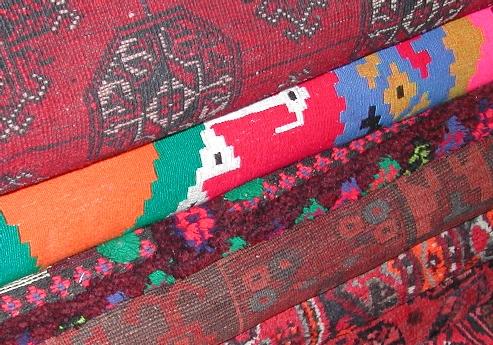
OUCH !, say my eyes !! But wait. Before we throw the baby
out with the bath water, lets look at the following examples, also produced
with synthetic dyes. But this time, in the hands of someone interested in
visual harmony:
A framed Tabriz pictorial rug:
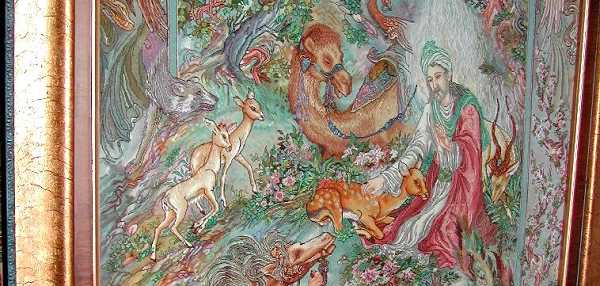
A border element from a Tabriz rug (there are more
shades in this little bit than there are in most carpets):
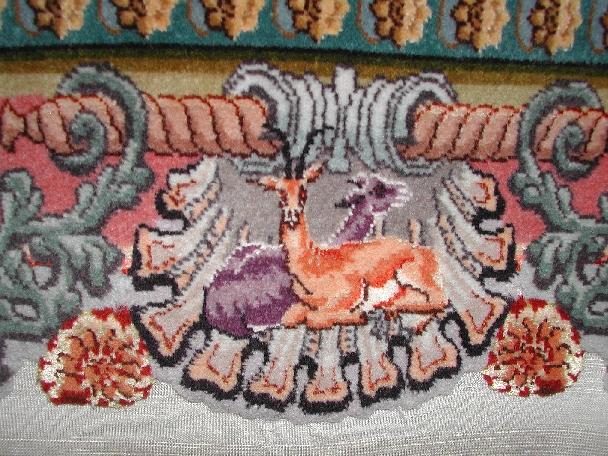
A modern Nain rug:
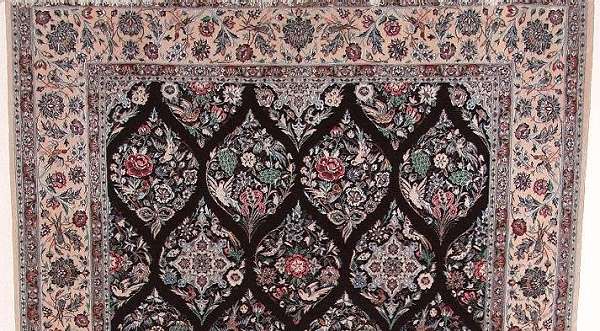
Note that none of the usual complaints about synthetic
dyes hold here. All have been exposed to light, none show any hint of bleeding,
and none exhibit the electric colors on the first image. So what do we say now
? Here is clear evidence that in the right hands, synthetic dyes perform as
well, or better, than the best natural dyes.
But wait Chuck: why, then,
don’t we see such delicate shades in tribal goods ? Economics. I think.
The number of shanks of yarn a weaver would have to keep in inventory in order
to produce colors like these is enormous. Few tribal weavers could afford to
buy and hold that much wool. And producing so many subtly different shades in a
rustic environment is not practical.
So, we see the transition from the
old to the new manifest itself in pretty unmistakeable ways. For starters,
we’ll look at an old Baluchi bag, the type Ferrier described as being
capable of holding liquids without leaking. This thing is like a board, very
tightly constructed, and with traditional colors:
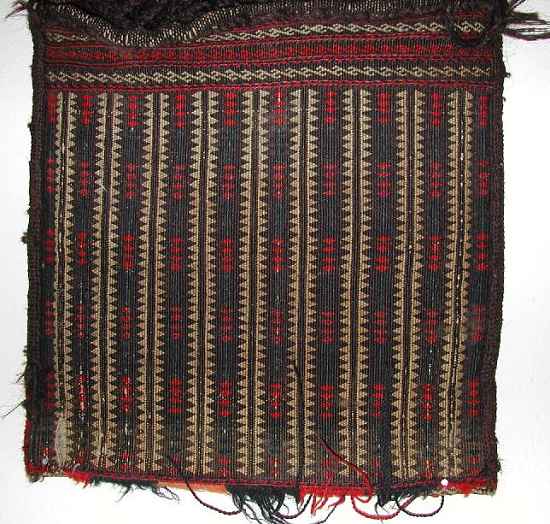
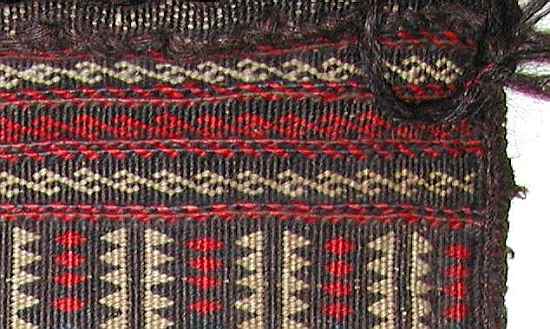
Now, put on your sunglasses. We’ll look
at some new Baluchi production. I don’t own it; the colors are too much
for me. But note that the quality of the weaving on this next piece is as good
or better than that of the old piece. There is well done, detailed, kilim work
here. So much that I doubt this is a piece just knocked out as another KITSCH
bag for the tourists:
The front
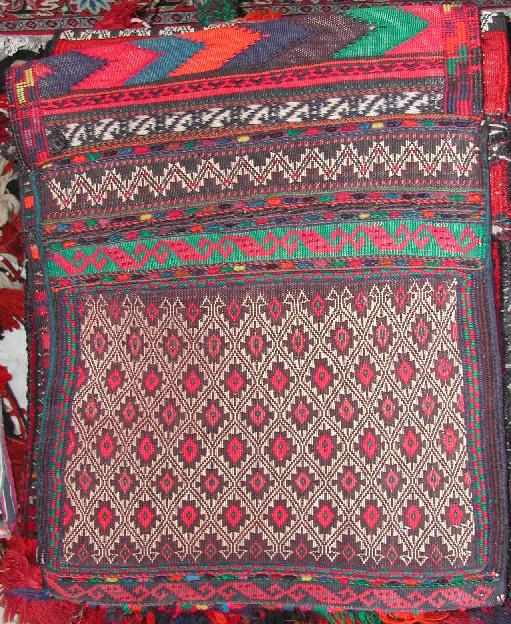
The back:
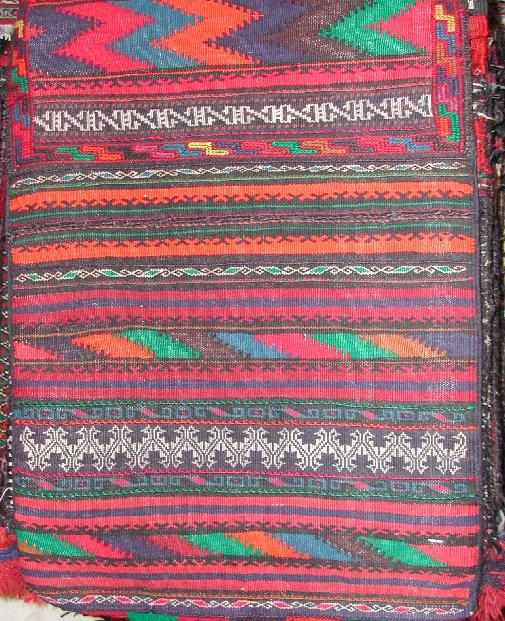
Detail:
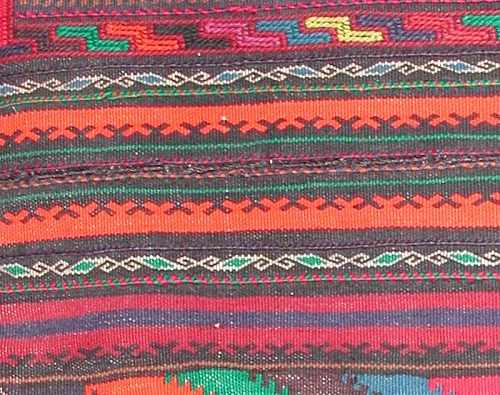
So, can a piece with such striking colors ever become
a collectors item ? The workmanship is superior. The colors are nontraditional
when compared to older bags. But what about in comparison to this bag’s
contemporaries ? Certainly, the market will determine what sells. But one can
hardly quarrel about how much work went into this bag.
And now, a topic
that troubles me: distinguishing natural from synthetic dye in the absence of a
gas chromatography lab.
Filiberto: So, it's difficult to discern natural
from artificial.
Michael: No, but it needs "training". To compare
synthetic alizarine with madder is kind of misinformed, as well as to compare
natural Indigo and synthetic Indigo.
I’m with Filiberto. And
here’s two examples of why. The first is a rug that I will claim is from
northwest Iran which I believe may be Bakhtiari. At first glance it appears to
be synthetic dye, but up close I begin to wonder. There is no tip fading, no
bleeding, the greens look like they’re loosing their yellow, and the red
has an non-electric, yet bright, character to it that I don’t see very
often. The dealer just shrugged and said “who can know with these nomads,
they use what they can get”.
The whole thing:
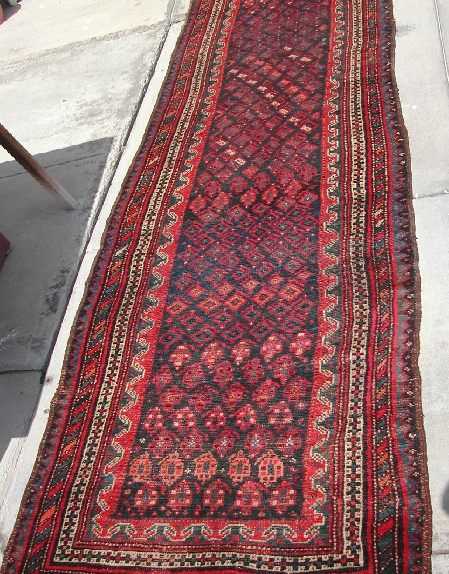
A closeup:
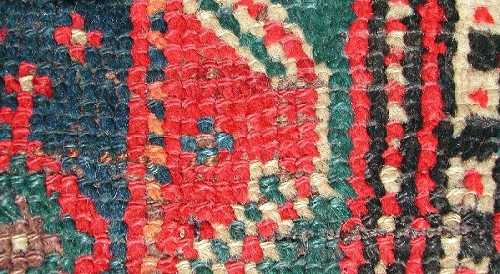
The back:
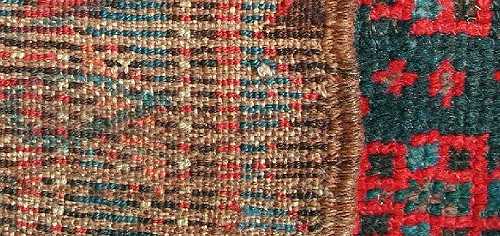
If these are synthetic dyes, I like them. I don’t
think they detract or reduce the appeal of the rug.
And next, a small
Ersari Afghan rug sold as having vegetable dyes. Maybe so, I’m not skilled
at distinguishing them. If it’s a synthetic job it’s not bad. As I
doubt this rug is more than 25 years old, I also doubt the natural dye
claim.
The rug:

A closeup:
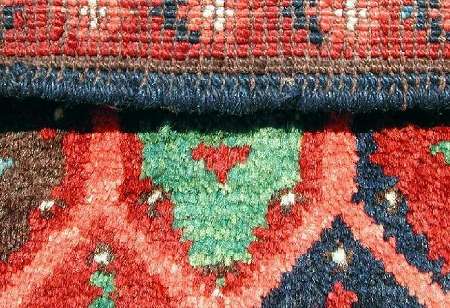
The knots in detail. What appears to be tip fading
actually runs the length of the yarn, a mix of lightly and deeply dyed
wool:
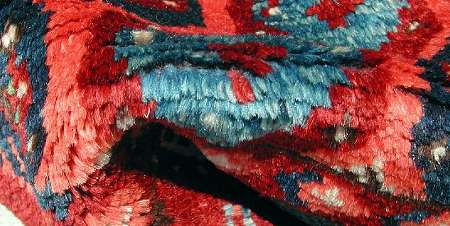
I’m not sure that the images are enough to make a
definitive judgement. But I think that, synthetic or natural, it’s hardly
an offensive piece even to the most hardened natural dye aficionado. And for
me, it reinforces Filiberto’s point: such determinations aren’t
straightforward, and depend as much on wool quality as the dyes
themselves.
So at this point my head hurts from trying to remember what
I typed the first time, before Microsoft helped me lose all my work, and
I’ll try to wrap up and hope that there was some continuity to this post.
My summary point will be augmented by a couple more pictures. Someone
put substantially more work into this piece than the usual junky fast-work
el-cheapo Baluchi bag that we’ve all seen, and dislike. To me, it’s
an example of what is some of the better flatweave Baluchi work being done
today, and the colors (I think) are not what they are because of economic
constraints but rather, what the weaver LIKES TO USE. Which makes them part of
the world of modern weaving art.
The bag:
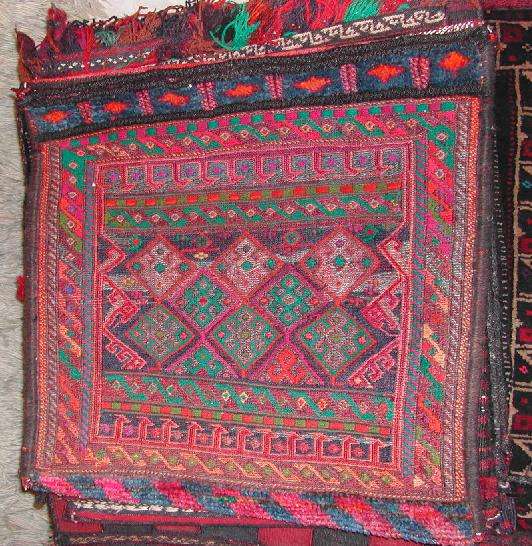
Detail:
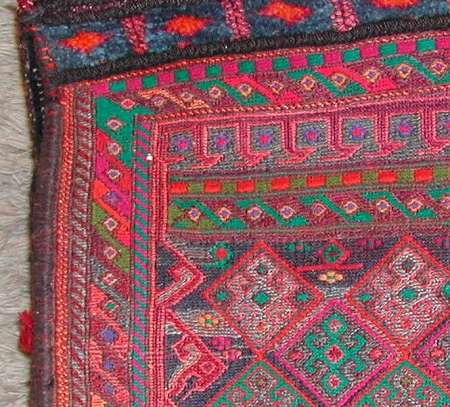
If you’re still here, thanks
for your patience.
Regards,
Chuck
__________________
Chuck Wagner
Posted by Michael Bischof on 10-04-2002 08:13 AM:
Dear all,
In fact, David, good carpets most likely have been the
exception and not the rule at all times! And one must be careful not to be
dogmatic when contributing to such a discussion.
quote:
...this does not hold true when assembling a
collection intended to reflect the range of variation exhibited by any order or
class of thing or object, be they insects or carpets,...
Wow, what a demand! The most collectors that I know, and I
mean the leading people in this field (like Kircheim, Vok, Dr. Pelz...) try to
get hold of the best specimens of a certain type. What they do not do is what
you describe here, David! Why? Scarcity of resources, I guess... therefore this
is not a thing that one should recommend to beginning collectors, wrong? In
other terms: why should (theoretically) do a private collector what museums
should do (... have done)? And how shall the collector provide the
necessary background informations to make such a collection meaningful? This
cannot be obtained by buying at touristic shops "at the source" or in the
class-A galleries in the West. I find the idea fascinating - and feel
disappointed by the fact that such "showing the variation attempts" do not
rarely exist.
A jump. Reading the discussion over and over I conclude
that by forcing the quality aspect of dyes too much I moved to a point which is
dangerous for my own taste: if one prolongs the logic I have offered the
logical end would be that only classical workshop carpets of the "high period",
14.-17. century, roughly, would meet those measures. Their dyes reflect the
upmost level that natural dyeing in those countries reached. And, as one may
conclude from the tiny scratches of written sources, these have been done in
well organized very big workshops.
But these I can admire only for their
technical qualities and not from an aesthetical perspective. That the
weavers executed in a robot kind of work alien designs in a quite perfect style
makes them boring for me. Though, for sure I would guess, abrash was a rather
unwelcome side effect of working in small scale and interrupted by other urgent
things to do, it creates some positive tension in a piece.
That is the
bridge to the question whether synthetic dyes can be used with some aesthetic
success in Oriental weaves of this type. All design types that show big areas
in one colour look horrifying with synthetic dyes. Because they are
automatically applied under very harsh circumstances ( to be
sure that metal-complex dyes are really fixed one has to drop the pH finally
down to about 2,5-3! And this in an environment where even for big firms
the use of an electronic pH-Meter is omitted in order to save some cents ...)
the little variations in the yarns are suppressed so that these big areas look
boring. Compare an early Turcoman weave ( beginning of 19th century) with a
20th century synthetically dyed piece! whether the latter is more than 100
years old in 2071 - what does this matter ? No one will be forbidden to collect
insignificant curiosities at that date, however, as I hope.
And a last
argument: the producers in Turkey have seen that the "imalat boya" approach
resulted in cheap, but pastel natural dyes of unsatisfactorily performance.
Plus: as weaving gets to be too expensive in Turkey the bigger producers rush
to the cheaper countries but are apparently not able to take this "technology"
over to there ... for this reason the hit of this season is to "copy" the look
of natural dyes in real old pieces by a kind of mimicry-approach - but using
the cheap synthetic dyes for that approach. If even these guys accept the
aesthetical hegemony of natural dyes in this field - why should collectors
bother themselves in collecting this "semi-antique" material? If a
collector needs something cheap (affordable) for use at home this would be a
different story. I would get headaches from it - but maybe I am a weakling in
this respect.
The pieces that Filiberto has shown I could stand only "at
the spot", with a glass of tea and a lot of jokes with the people ... and if I
would, by chance, meet my wife at such a location I could even buy one (but
later place it in her room, into the
shadow).
Greetings,
Michael Bischof
Posted by Filiberto Boncompagni on 10-04-2002 12:34 PM:
Hi Chuck,
Few quick points:
I regret I cannot comment on
Afghan war rugs from here. Jordan has very limited rug market, never saw one of
them.
A parallel between colors used in paintings and dyes.
As far as
I remember painters used to make their own colors until through the
Renaissance. The would-be painter started as an apprentice to work for a
well-affirmed Maestro in the Maestro’s bottega (workshop). One of the very
first task for apprentices was to grind minerals or whatever organic materials
they needed to produce colors for painting.
Later on, when in the 16th C.
the Academies - formation schools for artists - took over the traditional
craftsmanship methods of the bottega, I suspect things started to change. For
sure, when painting became an hobby for upper classes in the 18th C., colors
must have been produced by specialized artisans or small scale industries -
sort of like your village dyer in the M.E.
They still used traditional
natural materials because they were the only ones available.
Then the
industrial revolution and the progress in chemistry delivered what we have
today: industrially produced colors.
Some of them are still chemically the
SAME in use from the antiquity, some others are synthetic, some of the
synthetic are also new hues that didn’t exist before. Impressionist and
other artists did not produce colors by themselves anymore, (why waste
one’s time in a boring task when you can buy the stuff in a shop) so they
were obliged to buy the industrial ones and they were more than happy to
experiment with the new hues. Like our tribal weavers.
Regards,
Filiberto
P.S.
The dyes in the Bakthiari
and the Ersari - especially the Ersari - look very good to me!
Posted by Michael Bischof on 10-04-2002 12:36 PM:
Hallo everybody,
first: thank you very, very much, Chuck Wagner.
This contribution enlightened (?) me, let my mood fly higher ... I am not a
native English speaker. You know what I mean, hopefully. - I have had similar
hard experiences with the firm that you mention and since then I am a strong
fan of Open Source, reliable software and enjoyed a lot learning these new
tools based on a GPL basis. Like in making dyes: one should know what one is
doing ...
What surprises me is the frequency with which one
encounters leaky dyes in new city carpets today. Twenty years ago, you'd have
to look at several hundred Tabriz rugs before you could find one with leaky
dyes. Today, that number is more like thirty. It seems that the pressure from
emerging city carpet look-alike industries in India, Pakistan, and China, are
causing shortcuts to be taken in Iran and Turkey that were unacceptable not
long ago. I'm sure that collapsing currencies are major contributors to this
problem as well. It's certainly not because the emerging carpets are higher
quality than the older ones from the traditional weaving areas. They're less
costly. But inexpensive mediocrity seems to satisfy enough people to squeeze
the entire industry. Too much supply, not enough demand,
etc.
Brilliant! It would shift the topic of this discussion if I
would entertain you with backdoor details of how enterprises in these countries
work . It is not (!) lack of funding that makes people behave like this as the
medium and big producers are indeed very rich families. "Psychology" I would
denominate the reason why such people do not use pH-meters or engage qualified
people for having the job done. They need "slaves" and do not want to be forced
(!) to respect people who work for them.
The old measures, to a large
extent, still hold: No leaky dyes, color palette in harmony, lies flat, same
width at both ends, no obvious repairs (if they're obvious they're either badly
done or so big you should worry about them, right ?), structure and materials
compatible with the proposed origin, etc.
Fully acknowledged. For
the dyes: a grading from the more "harsh" to the more "soft" dyeing methods.
Important for the future performance of pieces. - Chemical wash I leave out: it
kills everything anyway ...
The modern Turkish kilim weavers seem to
favor ghastly combinations of a weird pinkish-gray, olive drab, dull magenta,
and brownish-yellow (and they don't seem to scour their wool very well. A lot
of it smells as bad as Bedouin weavings).
As a rule, yes,
acknowledged. What stinks is the spinning oil (often what is left over when you
change the oil of your cars motor: makes up some 2-5% of the weight that the
ready yarn has. Not much! But now, please, calculate in tons of wool to be
processed!). And the weavers, believe me, have no say anyway. They have to make
use of dyed yarns that the enterprising firm delivers. Do not blame them ...
when they work for themselves, for dowry pieces, they still use hand spun yarns
but bring them to he local dyes (see below).
Which reminds me: I
would like to point out that I do not equate the notion of a collecting with a
'cultural perspective'; or rather, a focus on a specific culture, with the
notion of developing a rigorously researched and documented provenance. This is
not required unless the end owner is a museum, a person with highly specific
collecting criteria, or someone whose net worth has been materially reduced by
the acquisition in question.
Those I had in mind, of course. This
elite of collectors provides us with nice exhibitions, drives the meetings,
publishes books .... what museums do in Europe is not even ridiculous, no bad
joke. "Bad joke" would mean there is one that exists ... I will soon report
here about an exciting kilim exhibition at a museum. But the true story is that
private people, elite collectors, were doing the real job. The museum just
delivered the otherwise empty space.
The idea, for example, that old
Turkoman pieces were not made for commercial purposes and are thus more
valuable than those made after the mid-19th century is notable for ignoring the
fact that Central Asian cultures have been trading textiles for centuries.
I agree - but the term "thus" is important. There was a much
higher level of technical quality, most likely backed by a higher local (!)
price, so it made sense to take care of quality, better trained customers who
ask for more than nice fairy tales...
Same in Anatolia or the
Caucasus.
To your pictures now: the city workshop pieces I cannot
comment. Not my taste, "alien" to textile works in my personal opinion. Like:
material and methods do not match the subject - but this opinion I also hold on
medieval tapestries. There is only one legitimation for them in my opinion:
natural dye lakes on wool look much (!) better than as a pigment in oil on
canvas. - But technically these seem okay.
The second Balouch piece: I
agree. Keep in mind that all these dyes a dye master could make from natural
source as well! But then this open rosy red, done saturated, would cost a
lot!
The Baktiari I do not dare to comment on the basis of these
pictures.
The Ersari is for me an example of a successful trial to
realize a traditional design with synthetic and natural dyes. Apparently these
are mixed in this piece. The "spirit" of such a weave is kept, except for the
green which does not fit into the piece.
And the last piece. I agree on
your comments of its better than normal workmanship. Interesting for me is your
remark about and the colors (I think) are not what they are because of
economic constraints but rather, what the weaver LIKES TO USE. No, I guess
the colours are what the local dyer has to offer. But most likely not against
any resistance of the weaver. Similar things one sees in Turkey: they bring the
yarn to the "corapci", who gives them to his dyer, and then back to the
customer. Or they have them directly taken to the dye plant, which are very
small enterprises. Local people claim that this was always like this! The
cottage industry, on the opposite and at least in Turkey, is not
traditional and run by people who came in from outside this textile
tradition, in most cases from the touristic shops. Their advantage is the
communication with their foreign customers what you can view in Istanbul, in
Cappadocia or at the sea side with ease. When a person like you would force
them into technical details they would lose ground immediately - and to ask
weavers forbids the status difference that they carefully
maintain.
Greetings,
Michael Bischof
Posted by
Michael Bischof on 10-05-2002 05:40 AM:
Here some pictures to substantiate my arguments.
The whole
concept was, as mentioned earlier: you find a master weaver (a skilled one
which grew up in a defined textile culture) - and all you do is to give natural
dyes to her, the best you can make or obtain.
Here are two results:
- one traditional design, of the rare cases where a certain design (and
colour style) appears, in fact, only in one village, a kind of weaving center.
In this area most families have a set of them at home, done all in synthetic
dyes.

and a close up of one corner:
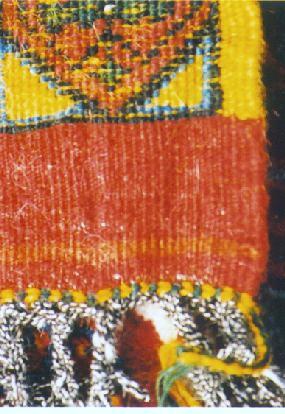
For dowry pieces it is done until today as we have shown
to Brian Morehouse two years before. We wanted to confirm that our claim,
previously done to him in written communication, that these pieces (his cover
piece!) were all from Taskale/Karaman. To earn money most of these weavers work
Caucasian whatsoever designs for Konya- or Istanbul-based firms (2). These two
"threads" coexist there.
- the second one (yellow ground) is a traditional local design, but not
restricted to one village.
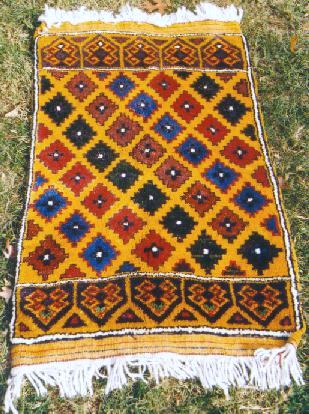
Of course digital photos do not transport all. So I cite Walter
B. Denny, who has seen such pieces and learned to know the weaver of these
pieces, Susan Yalcin, as well as the dyer, Memduh
Kürtül, together with a Washington Textile Museum group when they
visited Konya some years before, as a reference.
Picture quality
(and therefore dye rendering) depends also on file size. This is an 44
kB-.jpg-file.
For yastiks I would urge you to have a look into the
"standard reference book" of Brian Morehouse. On "what is collectible": to
mount such an exhibition it was necessary to grab into many different
collections. Even the best collection of the world which has been started in
the seventies (!) does not contain more than 100 pieces, round about. Since
accompanying this experience I think it is better for a collector to prefer 2-3
masterpieces and leave the job of showing the varieties in the genre to the
museums or other public foundations. Otherwise one has to compromise on quality
or would run out of money.
The nicest natural dye red that I have ever
seen in any Oriental weave one has in no. 30 of this yastik book. Attention:
viewing the colour plate in the book you cannot see what I mean. I refer here
to those readers who have seen the exhibited piece. Whether the red was made
from Cochenille using a special dyeing method (what we later did several times)
or whether it was just the lucky day in a professional dyers career working
with madder (what we constantly repeat, but in very small amounts) I do not
know. Into the analytical methodology I jumped later (1). For people who have
an eye for that: that is the "impact dye". You view it, in the right light, on
a silly day - the day is your friend. Others may do it with music
...
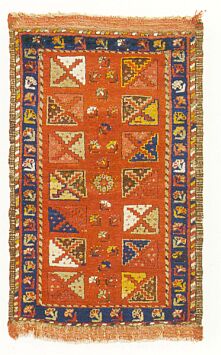
pl. 30, Morehouse
At that time the
previously mentioned A-, B- and C-piece grading played no role. This is an
A-piece: the village from where it came is known. There were 3 pieces of the
same design, may be of different age ( this can well be), but only this one had
this red. The other two minor pieces had no real commercial value,
antique, but mediocre, and were channelled to some tourists, but not to an
important collector. I guess that I still have some pictures of them.
One thing is obvious here: with natural dyes, in old days as well as
today, dyes cost different amount of labour (and therefore money). There are
expensive dyes and cheaper ones. The very saturated plus
vibrant/luminous/vivid/eye catching rosy-pink shade of madder was/is the luxury
dye. Therefore in early material it is used as a highlight, not in big areas
(as it is today with its cheaper substitute - a piece with a look like the last
Balouch piece in Chucks serial 200 years before would have shouted: "look here,
I am rich !").
Out of sheer luck this contribution can show
"varieties": one traditional design, small deviations ... so we have 4
from the same design, 3 antique, 1 new. The design seems to be "clearer"as the
pile is worn down in the antique material.
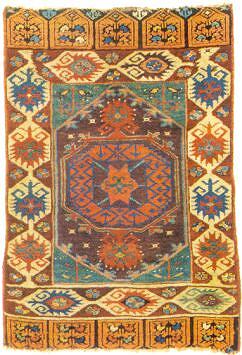
pl. 55 , Morehouse
And one more:
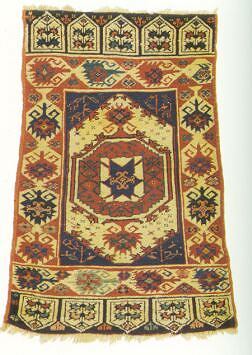
pl. 56 , Morehouse
Please also notice another
variation in the application of one "hook" in the upper "ayak" (the local
people use this term for these elem kind of appendix above and below the main
field). There is no space here for design discussions. Just a short note.
Carpet designing without using a ready design paper works like muscle (body)
language. As one might do mistakes when setting one foot in front of the other
while one is occupied with certain thoughts the same can happen to a weaver. Or
may be too much focus on gossiping while doing the weave? (More likely).
Greetings, Michael Bischof
(1) Fischer, C.-H.,
Bischof, M., Rabe, J.G.(1990): Identification of natural and early synthetic
textile dyes with HPLC and UV-Vis-Spectroscopy by Diode Array detection.-J.
Liq. Chrom. 13: 119 ff.
(2)They hate the
"natural dyed" yarns that the Konya- or Istanbul-based cottage industry firms
force upon them: they are dirty, stain the hands and in one case caused
inflammation. When some of those dyes fade in the chemical washing process
weavers are accused of having made mistakes in setting the colours according to
the design paper - which leads to money cuts.The guy responsible for this, who
sits in Konya and who did this for a well-known firm in Istanbuls posh
Nurosmaniye Caddesi, got recently a very favourable article in HALI.
Posted by David R E Hunt on 10-05-2002 10:12 AM:
clairification
Mr Birtschof and all- Thank you for the response to my post,and be at
ease, for there is no need to misconstrue the pedagogical tone of my post. It's
just my writing style,in person I am rather more jocular. You have raised an
interesting question or two, so perhaps I can clairify. The purpose of this
last post, with it's analogies and similies, was to demonstrate and walk one
through the temporal process of justifying the inclusion of "lesser" weavings
into the body of collected cataloged and recorded weavings. I agree completely
that one should by the best examples obtainable, for their class or type, but
that these other rugs have much to tell us, perhaps the body of the story of
weaving art. We would do well to see and record, if even through photography if
nothing else, as many rugs as possible, for after viewing a goodly size
representative sampling of rugs,naturally occuring categories and groupings
suggest themselves and emerge, constituting a progression of design or
developmental framework indicative of a chronology. The sum of the body of
weaving history is so diverse, the holdings so dispersed, the sheer enormity of
the task of even deginning to accurately document a representative sampling of
these rugs, as reflected in the state of contemporary Turkmen scholarship,
places an onus upon the inclusion of lesser weavings into the recorded body of
carpet documentation.In short we need collectors of "lesser" rugs. Also, I
myself do like the idea of a "demonstration of the variation", as in
concentrating uponTekke chuvals from the early , middle, and late periods, with
an inclusion of representative samples of the different designs produced during
each of the three periods.- Dave
Posted by R. John Howe on
10-06-2002 01:48 PM:
Another Yastik
Dear folks -
Michael Bischof has put up three examples of a
particular yastik design, designated by Morehead in his "Yastiks" book as from
Karapinar. Michael indicated to me a year or two ago that' in fact' this design
is seen as their own by a particular village in Turkey populated for the last
200 years by Yomud Turkmen who came from Khorrasan.
I own the other
example of this design to which Michael referred above,
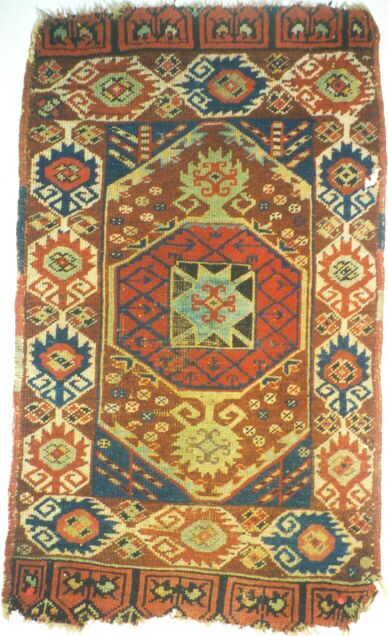
which we estimate to be later than the two Morehead
examples, perhaps turn of the century, as we often say when we can't really
make an estimate.
Perhaps Michael will want to comment on the
differences he sees in these pieces, since they do seem to be instances of a
single design woven at different times.
On two different tacks, let me
also say that while I appreciate "natural" dyes greatly, and mostly collect
things that have them, I am not as passionate as Michael with regard to the
presence of a synthetic in a piece that is, despite this, attractive to me.
I bought still another yastik this week (I have no photo at the moment)
that has a red ground that seems likely to me to be synthetic since there is
transfer of this red to the warp threads. Nevertheless, despite the presence of
this synthetic and that fact that this piece has no great age, I find its
graphics very powerful and compelling.
Secondly, if I understand David
Hunt's thought about needing collectors of "lesser pieces" above, I think I
disagree. David's logic seems to be one of the desirability of
representativeness. While anyone can collect what they want, I personally would
want to restrict myself to things I find attractive.
The notion that we
need to "map" the modal Turkmen pieces woven seems to me somehow similar to
Senator Roman Hruska's famous indication that Nixon's Supreme Court nominees
Carlswell and Hainesworth, needed, despite their admitted lack of legal
distinction, to be considered for appointment because "the ordinary American
citizen" also needed "representation" on the Court.
I personally want
to collect the items that I can afford that seem attractive to me and are of
the best quality I can discern and manage. I am willing to leave to
anthropologists, if they are interested, the mapping of modal
mediocrity.
Regards,
R. John Howe
Posted by Michael
Bischof on 10-06-2002 03:25 PM:
yastiks - continued
Hallo everybody,
personally I am "hunter" - this means for me to
try to catch pieces that make me excited from joy. This documentation aspect
creates, on the middle and long run, the necessary tools. Indispensably needed
but boring, in the middle of such work. Another aspect: other people may have
had more luck. I am restricted in this hunt by the scarcity of ressources. So I
would not want to scatter them around with mediocre things ... and there is a
psychological problem: when I have to document a decay, a process that shows
down the hill, I would find it difficult to avoid melancholic feelings. So,
David, what you propose I would like to leave, as R. John Howe would do, with
museums and their stuff. I am really willing to share with them any news which
I collect and that is valuable for them but is "Beifang" for me ( the little
fishes of no use that may block the net).
The yastiks: I guess that the
piece that R. John Howe owns is the youngest of those published here. Repeating
that any statement based on digital photos is kind of preliminary I see that it
has the least saturated dyes. The dyes in his piece are okay, but I see
Indigosulfonic acid blue - and this means in the context of these Central
Anatolian weaves end of 19th century. But not 20th century ! There is a design
mistake obvious in this piece. Look at the corners of the main field. A "tree"
type of motiv is executed wrong. As stated before weaving motives is like body
language. Weavers keep in their "body memory" small units of a motiv that they
put together while doing the weave. Here a left thumb was attached to a right
hand ...
But the same type of mistake can be noticed in Morehouse pl.
56, at the top of the piece. Some hooks are turned wrong. The piece of John is,
in addition, clearly more coarse than the other two. This fact and the design,
which is a bit more schematic, does not allow to assume age differences, I
guess. The colour argument is more important - for me.
Its a pity that
we cannot sit together and handle the pieces which we are talking about.
Because a great dye simply means much more sensory pleasure - this is the
reason why I favour these natural dyes. The synthetical ones do not exhibit it,
being flat in comparison.
To come back to Chuck Wagner and his first
shocking picture ( I mean the kilim): it makes no sense to speculate about what
weavers might like. In the moment they could easily follow their old
preferences for bright and eye-catching dyes with the introducition of
synthetic dyes the aesthetics of their textile works broke down - before
that, in the natural dyes age, it was not impossible , of course. But very,
very unlikely ! Which weaver would have had that much money to obtain such
masses of eye-catching dyes from the dyers ? Make a Yüncü type of
kilim from really saturated pure madder red , that means no "imalat
kirmizi", it will be beautiful just because this red alone is beautiful.
Do the same with chromium red ( its dye principle comes closest to its natural
dye idol - it is a dye lake as well) and you will gain a boring "something big
red".
To remember again: the basis for this whole discussion is how an
unused mint condition textile looks alike ! In the moment we speak of our
preference for pieces whose age we can "feel" we lost any material basis: we
discuss our own imaginations, sentiments,
then.
Greetings,
Michael Bischof
Posted by R.
John Howe on 10-06-2002 05:07 PM:
Michael -
You said that it is likely that the yastik I have just
put up is likely the youngest of those posted here. I think you mean it is the
youngest of the three "antique"
pieces. The Susan Yalcin piece,

despite the great care that has been taken to dye and to
weave it is contemporary and so much younger than the
others.
Regards,
R. John Howe
Posted by Michael
Bischof on 10-06-2002 05:22 PM:
Hallo everybody, hallo John,
indeed - I thought it was not
necessary to mention that ! (' ')
')
To Susan, who has, of course,
seen the other pieces in the book, all were quite familiar.
And she
immediately recognized the design mistake in pl. 56 - as she says in her
village the majority of girls do not have talent for weaving and no big
motivation. It is simply an important way of staying alive - and today the
amount of weaving is much higher than it can have been in old times ( when they
used exclusively their own wool - there were no streets to the village, just
narrow paths for horses, donkey and
camels).
Greetings,
Michael
Posted by R. John Howe on
10-08-2002 05:48 AM:
Dear folks -
Before this thread goes away, it might be good to
make a point relating Michael's concern about getting the best natural dyes one
can, to some of the aesthetic standards we employ that are related.
The
first contemporary piece that Michael has posted by Susan Yalcin is to my mind
a good one for illustrating the fact that dyes and "good weaving" alone do not
always add up to the optimum aesthetic effects that we might value.
Ms.
Yalcin has taken care to use wonderfully saturated natural dyes of apparently
very high quality. She has also taken care not to make the drawing mistakes
that Michael has pointed out in the renditions of two of the antique pieces.
She has also made sure that the sides of the central medallion do not touch the
side borders. This latter feature, is a generally, sanguine one, I think, since
it makes the central medallion "float" nicely on its field. Ms. Yalcin has also
retained the more articulated version of the cruciform devices that are in the
inside of the "insect" devices in the border and that also occur in the center
medallion. (If you look at my "antique" piece you will see that these have been
greatly conventionalized in the border renditions there.) Last, Ms. Yalcin has
avoided the use of "filler" devices that appear in the field of my later
"antique" piece and that seem to characterize later renditions.
But I
have suggested to Michael that the Yalcin piece can be critiqued aesthetically
in comparison to other older renditions.
Perhaps the most serious
critique I would make is that the Yalcin piece is too narrow to permit drawing
of the central medallion without touching the sides at a size that occurs in
the older pieces. It seems to me that the necessary "miniaturization" of the
central medallion works to reduce its graphic impact greatly "vis a vis" the
older renditions.
An additional quibble is that Yalcin has used a
"two-leaf" verson of the lappet design rather than the older "three leaf"
version that Morehouse says occurs in pieces woven before the end of the 19th
century. This adopts a conventionalization of this design and makes it less
fully articulated in this respect (but there are some Ottoman velvet pieces
that show five and even seven leaf versions of this approximate lappet design).
Last, is something that may be personal and that Ms. Yalcin might
debate with me (Turkish weavers sometimes find distinctive color combinations
attractive). I think her piece would be FAR more attractive if the side
selvedges were in the red of the field rather than in the very strong yellow
she has used sparingly there.
I make these critiques depite greatly
admiring some other aspects of the two Yalcin yastiks above. I can demonstrate
that I do so in part because Michael made it possible a year or so ago for me
to own both of them.
But I thought it important to notice that
wonderful, expensive natural dyes, and carefully, skilled weaving do not
necessarily produce optimum aesthetic effects. These are always a separate
matter.
Regards,
R. John Howe
Posted by Michael
Bischof on 10-08-2002 07:38 AM:
Dear everybody, dear R. John Howe,
thank you for your critique!
Yes, of course, dye quality is no guarantee at all. Therefore more than 90% of
the antique piece that we came across are not "great" in case we apply this
critical view to them - and one should do that! But now imagine, please, what
would have happened if in addition to aesthetical details of drawing that you
dislike there would not be a kind of balance by sheer pleasure of viewing
saturated natural dyes? If one would have some "dead" synthetical dye of
thesame nuances instead? - I am curious now: how would you discuss the other
yastik?
Chuck Wagner complained about bleeding dyes. This is not the
only important aspect. The second one is light fastness! Today we need higher
degress of that than 100 years before. Modern pieces are not put into very dark
Oriental adobe houses.
In order to come to a result that is useful for
the collector one must look for the socio-economic "environment" of how
the (synthetical) dyes were applied.
The period and the style of
application of the synthetic dyes I would like to split into two categories:
synthetic dyes in the hands of professional dyers, applied by
educated know how and equipment ( potentially: we deal with the Orient here
!)
- synthetic dyes applied by village women or uneducated local dyers or
"corapci"-kind of people
The technical (and, most often, the aesthetical) problems we
encounter with the second group. Leaving aside fuchsine the first major
application came with azo-dyes. Their fastness is low. In the firt period one
tried to substitute natural dyes with them - as a cheaper alternative to
the bright and pure shades of natural dyes (saturated, but
mixed or broken shades were still done with natural dyes. This mix was
applied till recently in Anatolia). The technical problems that surfaced
motivated the people to change to another method quite quick:
to top unsufficient or "broken" madder reds with red
azo-dyes
This combination is most likely the most important source of the
trouble of late textiles with mixed sources - as one encounters washing
problems: the azo-part of the dye is quite fugitive and tends to bleed. Because
they were applied in an amateurish way by uneducated people. Anyway: even if
one would see such a thing in mint condition this "mixed" red dye, though its
nuance may come close to that of a splendid saturated real madder
rosy-red, is second to the latter. The sensorical pleasure is simply lower.
Difficult to demonstrate, impossible to show via photographs - ask the most
experienced collectors and dealers for that. It comes close to the
peculiarities of tasting wine! You may believe that, may be, only after having
followed a blind test (what they always do with wines here in Europe at wine
contests!).
In addition to the azo-problem we have, but a bit later,
the acid dyes which are applied with great ease in any household pot. Very
soluble in water, a quick job, an "instant dye" (common until today). Everybody
could buy some grams of it and apply it at home. With these dyes all Oriental
weavings lost ground: Very low fastness to washing, quite low fastness to
light. These are the dyes that mellow in the sun - and one must "burn" them
(call it "soften") to sell such material. The fact that then the wool is
attacked one may override by fairy tales: happy carpets that were on holiday -
sun bathing! If it is not enough - chemical wash, and the piece is your friend
(shall I call it: "dealers little helper"?).
Later, in the twenties of
the 20th century, the industry ddeveloped chromium dyes. These are applied
similar to natural dyes:
The wool is mordanted with potassium bichromate
(the earlier mentioned ultra-toxic compound and then
dyed with synthetic chromium dye-stuffs, whose composition is quite close to
natural dye stuff molecules. This process was never in the hand of village
women as one has to handle dangerous chemicals as sulfurous acid. - Recently a
ready compound, the dye-stuff complexed with chromium or similar heavy metals,
was introduced: the metal-complex dye type. Their application is quicker: good
soluble in water. One heats the fluid, adds the dye stuff and then, slow by
slow, adds strong acids to drop the pH (this makes the wool dry and brittle).
Excellent fastness to light and wash (if properly applied!). One needs
at least an electronic pH-Meter - which I have never seen in any Oriental big
commercial dye plant!
Each professional cottage industry enterpriser
will confirm that ne can manage these chromium and metal-complex dyes so good
that the majority of customers mistake them with natural dyes - one dye cannot
(!) be substituted: there is nothing to replace Indigo (but only
synthetic Indigo is used, including practically all
"natural dye" makers 1 ). This has no "romantic"
reason: vat type of dyes are no longer in use for wool but have an own visual
impact that differs from dye lakes.
If one digests all this information
I cannot see where the merits of textiles of the first group should be.
Bleeding colours of low fastness to light and of offending colour combinations
(when intact: not bleached, not chemically washed; when "softened" their
integrity is in question) - why should one collect these except in rare and
well documented cases or as occasional souvenirs?
the
Gashgai ladies which selected these synthetical offensive dyes
...
Yes, it is their taste: but it is as well the selection of
people who have no other choice ! ... as natural dyes with their "built
in" colour harmony guarantee are no longer available for them. Plus: this taste
evolved in an extreme long period at times where these bright dyes meant
something.
If one would eat 10 apples per day no harm would arise. But
in case one would eat the equivalent amount of industrially processed material
"out-of-apples" after a certain time one would bbe ill. Not the taste of those
Gashgai ladies is wrong - they should have taken into account that the objects,
that are to be selected or preferred, the dyes, have changed substantially! Old
measures are wrong measures then. Till new successful designs using the new
dyes have evolved the results of traditional skills and designs combined with
new synthetic dyes are ugly and inferior. As waste of skills we might see it
from our perspective - as a loss of visual pleasure and taste for the people
who create and use these things it looks from their perspective.
To
stop any speculation: we have tested this in Karaman - if one lets the
ladies select whether they may have saturated natural dyes for knitting a
pullover or even brighter synthetical dyes they prefer the first ones ! From my
personal background as a biologist I insist on the principle: facts first!
Colour is a major aspect of all village and nomadic textiles. If this element
is lost or crippled - what then?
Greetings,
Michael Bischof
1We had a lot of quarrels with a lot of
producers in the last years for this problem. We uphold the message
"natural dyes should be natural dyes" - and have been
shown as some stupid naive amateurs, unable to cope with the mainstream of
today. Practically any dealer who signs a receipt using the term "natural dyes"
for contemporary weaves commits the crime of cheating: it should read
"partially natural dyes".
Posted by Vincent Keers on 10-09-2002 06:36 PM:
I'm all natural
Hi Michael,
Maybe "Vegetable dyes" is a more to the point
description if you want to distinguish
dyes that are (more) natural and dyes
that produce less environmental harm.
It's obvious the vegetable
products can't be the manipulated ones.
That's even more
absurd?
Imagine......one vegetable is manipulated in a way it can deliver
all sorts of colours.
What a mess!
I'm the product of mother nature
too. And mother earth will spit me out the moment
they put me under. If they
burn me, the sun will disappear for months............
Yep. I'm the healthy
kind of guy.
Best regards,
Vincent
Posted by Chuck Wagner
on 10-10-2002 10:39 AM:
Hi All,
I have another question that I'd like to put out on the
table, which isn't really that easy to state simply. Here it is:
Outside
the "weaving-under-contract" world there are still a lot of village, cottage,
and nomadic weavings that reach the market. Are those weavers aware of the long
term behaviour of the synthetic dyes they're using, and what portion of those
weavings have faded dyes as a result of the intent of the weaver
?
Certainly, they're all aware of the existence of vegetable dyes. But a
quick trip through Google will demonstrate that the vegetable dyed wool
available around the world is roughly twice as expensive as synthetically dyed
wool. I have to assume that same porportion is roughly correct for the dyes
themselves.
So it appears that even for pieces made to be used by the
weavers (or their families) for some time before reaching the market,
synthetics are in heavy use. But over time, they must see the fading in their
own goods. Do they just shrug their shoulders and wish for the old days, or are
they happy when they bright colors fade and soften ? I have seen several (and
own one or two) items that have a faded blue that - UNFADED - is way out of
balance with the rest of the dyes in the rug. But after fading, its saturation
and contrast are more in line with the rest of the dyes.
Is that an
accident, or is it intentional ?
And another question along a line that
Michael touched on, the circumstances of the dyeing process itself, and related
tolerances for temperature, etc:
Isn't the same true for natural dyes ?
There must be circumstances where the preparation and application of natural
dyes is done badly. Many nomadic folks prepare this stuff over an open fire
pit; hardly laboratory conditions. I'm not so sure that fading or running is
necessarily a certain indicator of synthetic dyes (although I recognize that it
generally is). Comments ?
Regards,
Chuck
__________________
Chuck Wagner
Posted by Michael Bischof on 10-10-2002 03:28 PM:
Hallo everybody,
to avoid environmental harm is a future job of
making dyes. It will not be the carpet section of textiles who will pioneer
this, that is for sure. Vincent, you mention Imagine......one vegetable is
manipulated in a way it can deliver all sorts of colours. What a
mess!
Well, that already has happened. In the US they started quite
some years ago to use genetically engineered bacteria to produce natural
Indigo. Maybe we have soon A-Class (real natural Indigo) and B-Class
(genetically modified material) Indigo?
"But a quick trip through
Google will demonstrate that the vegetable dyed wool available around the world
is roughly twice as expensive as synthetically dyed wool. I have to assume that
same porportion is roughly correct for the dyes themselves."
The
real differences are, according to the quality, much bigger. "Only" twice as
expensive? T hat means it is "köklü boya". Whatever, since this
tradition got extinct in the whole Orient without having had produced enough
written sources to revive it from its own weavers who would like to use natural
dyed material are kind of victimized. They can get only what cottage industry
producer supply to them. There are no dye plants where normal people go and get
natural dyes - simply because there would be no market for that.
What I
described from Taskale and Karaman (the neighbours of Susan Yalcin) is a very
special case that cannot be taken as a kind of general situation.
Notice
please, that both approaches work very different from each other:
the cottage industry has to produce items that must be sold
directly, mostly to foreign markets, when there finish is done. The aim is to
produce something that resembles in a way antique pieces which must be
substituted because they are worn out.
- the weavers that you have in mind produce some utility weavings for
their own and occassionally sell it. Because there is a surplus of offers which
is not balanced by demand (keep in mind the huge masses of people who flee from
the villages to the cities) the prices are so low that the old economical
principles do not work any longer.
Of course they realize that light and use degrade their textiles
quite quick. Nearly all weavers that I know do not like it - so it is not a
planned enterprise of softening down offensive dyes. They do not find it
offensive - they spontaneously like bright dyes! Just as the previously
mentioned Gashgai ladies ... later they are disappointed when a technically
well done "softened" carpet does not catch a small fraction of the price that a
100 years old piece, with much stronger natural dyes, would fetch... if the
deal would be straight.
Synthetic are not "in heavy use", as you say,
Chuck, they are for this purpose in exlusive use.
People shrug their shoulders, yes. What can they do ?
As a result I
would guess: to visualize the degradation of dyes as "softening" is a Western
attitude which is not shared by the local people. Each collector starts, as I
suppose (I am no exception!), with some "semi-antique" pieces of mellowed down
synthetic dyes which he mistakes (!) with natural dyes for especially this
reason. It is a beginners mistake. When one starts to go to the museum to study
the best available materials this attitude changes very quick. The better piece
is always the enemy of what we found good until that very
day when we start to learn ...
I spent more than 20 years with
the effort to find out what is left of old dyeing know how. And I did not do
that alone! All nomadic people in Anatolia that we met say: we never did dyes!
This is an occasional habit of settled people. And even these say frankly that
they did only the "minor" dyes sometimes on their own - the nice, bright
colours they got from the professional dyers in the next township. Rests of
this "minor dye" know how are still there (walnut browns, dark, a bit dirty
ochre-yellows..). And these fade, indeed.
It seems so that some old
methods of dyeing with powder-like extreme fine grinded madder resulted in a
lower rubbing fastness - but as stressed before on
Turkotek this should not be mistaken with "bleeding", which is a different process.
In most
antique kilims or village rugs one will find some of those "minor dyes". To
which extent they endanger the aesthetics of the piece depends on the single
piece and on some luck. This amount will regulate its price then.
To use
open fire when making dyes is in most cases
detrimental to the integrity of the wool - and to the
dye quality! It makes nice photographs of true authentic charisma (for the
semi-informed, though). These pictures add to the enormous amount of uninformed
nonsense
that dominates even the "professional approach literature" on the topic of dye
making. As the price of the merchandize is connected to the processing details
this makes at least some sense.
Especially if one uses fire to
mordanting the wool will get attacked, brittle and lacklustre. Certain
preparations for yellow dyes would not damage the wool that much under this
condition.
Whatever: everybody who would make dyes will sooner or later, on
a silly Monday or whenever, sometimes produce something which is weaker than it
should be ... but if the process is "soft" (and slow, then) it will not attack
the wool's integrity and one would have, as the ultimate damage, a stronger
colour shift than it was planned, that is all, from a middle yellow to a nuance
which is a bit more ochre, which is unavoidably with flavonol type dyes anyway.
But never ever from strong ("offensive") violet-blue to a light grey like it
happens with this "semi-antique" material.
Greetings,
Michael
Posted by Bob Kent on 10-10-2002 03:57 PM:
Better Fuchshine that Fled (than Too Hot a Pink-Red)?
LOve the thread. It started with a question about how the pursuits of
ethnographic interest and natural dyes play out in for example Kurdsih
weavings. Reminds me of this big red devil:
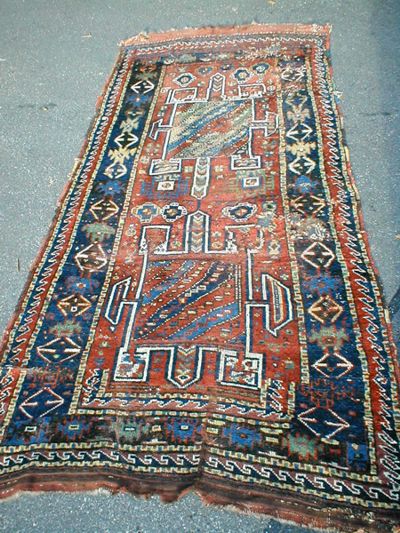
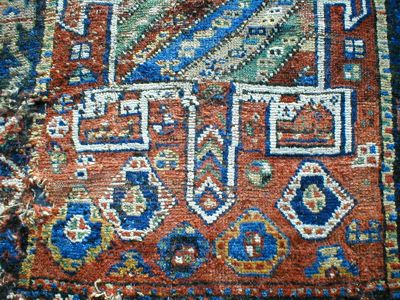
Show those holes to a
non-collector, they're put off. Collectors love the borders, wool, colors, and
may even wax a bit about the ethno-associated (i.e., Quchan) howzi design at
first sight, but then they notice the faded pink bands across the medallions
and forget some of what they got just by looking at it. I like it, and
appreciate the fact that its 'neither fish nor fowl' nature means I can buy it
for money that might pay for a nice dinner (OK, a nice dinner with nice
drinks). And here's the really heretical part: having seen the 1970s color of
the knot bases and some Kurdish rugs of similra age with pinks that didn't
fade, I am glad it's a chemical pink strictly on aesthetic grounds. The
resulting cooler pink isn't too out of balance now, and nothing should be so
bright as to distract from the borders, blues, and green.... rock on, Bob
Posted by Michael Bischof on 10-11-2002 09:29 AM:
Hi Bob,
that was a pleasant but funny return!
Bravo!
The question that we discuss here, "what is collectible ?" (apart
from the fact that everybody might choose what he likes"), harvested different
answers. One further proliferation is yours: "semi-antiques" with synthetic
dyes can be collected insofar they are sufficiently
"damaged". But then we have already passed the "textile art" exit,
didn't we?
I can well accept your point. If I would select I would as
well select that piece that means less offense to my eyes. But behaving
in that way we automatically, implicitly, state that synthetical dyes are
aesthetically a deviation, a kind of reduction, of what we aim for.
The
consequences for "evaluation" are crystal clear - anyway. My question how one
can speak of "ethnogrpahical value" in case he does not know the real context
of a particular piece (anonymous
"Strandgut" from the trade) had no feed
back until now!

Greetings,
Michael
Posted by Bob Kent on 10-11-2002 10:16 AM:
eyes not dyes!
michael: yes, with my usual febrile and rather small-minded seriousness,
I mean it: I am glad that the evil pink in the stripes of one medallion are a
faded chemical dye. I've seen the knot bases and the orginal color was
out-of-hand bright, anticipating the 1970s by most of a century. from an
ethnographic point of view, some might want that aesthetic choice of the weaver
to be preserved, but to be honest I think people would wince if they said this
looking at the knot bases. I think it's a fun rug that was made with one wacky
color, thank you photons. I just saw a kurdish rug with a natural pepto-bismal
pink that I'd pay someone to replace with faded dye, honest (well you know what
I mean). so who's to say that chemical dyes are _always_ bad?
plus, if
the kordi rug had all natural dyes I don't think I'd own it, too much money
business. of course I see steve's point about age, but I don't expect many
kurdish rugs to be really old anyhow, heck the ones with fuchshine may
sometimes be older than ones without. I agree with steve's idea that weavers
liked bright colors. but they don't have to deal with my wife (who already
wonders about the ventilation). I think the pink in this rug would have been
evil from day one.
regards.
Posted by Chuck Wagner on
10-11-2002 04:36 PM:
Deja Vu All Over Again
Hi Michael, et all,
We now pass close to the original topic of
Rick's: whether or not it's reasonable to exclude pieces from the "collectible
universe" because they are constructed using synthetic dyes.
I think
it's important to note that the ethnographic component of rug collection
typically has a temporal element to it: As time progresses, cultures migrate,
comingle, even disappear. Their socioeconomics and demographics evolve. So, a
given area of collection concentration usually focuses on some window in time
in addition to a specific weaving group.
Such windows includes today,
and, the future. To exclude the woven record of some uniquely identifiable
weaving culture from the collectors world because synthetic dyes are used
implies that almost all future weavings will be of no interest.
The
Kordi piece may not be documented well enough to sell for hundreds of thousands
of dollars, but it still represents a snapshot in time of an evolving culture.
Many rugs are in the same category: pretty clearly attributable to a specific
subset of humanity, but not precisely so. So I side with Rick, still, using the
case of the Afghan refugees as my example. The explosion of non-traditional,
but temporally unique, weaving associated with the Afghan diaspora will not
persist over a long period of time. Their lives will get back to normal,
hopefully, and a more settled and slowly evolving period of Afghan weaving will
be upon us. On time, those weird war rugs and psuedo-Kafkaz lookalikes will be
recognized as markers in the historical record.
One other note: I agree
with most of the points you made in your last couple posts, but I'm not ready
to buy the part about the dyemasters not using wood as a fuel, just yet. That
may be the case TODAY (and recently) but I wonder if (for example) all those
villages peripheral to the Dasht-i-Kavir, Khorasan, or the Turkmensahra had
meaningful quantities of affordable natural gas available to fuel the dye bath
heating process until the mid-20th century. Yet wool was dyed, and carpets were
woven. Anyone familiar with wood burning fires knows that maintaining a
constant temperature with wood is a real headache. Coal would be a reasonable
suspect for a suitable fuel, or oil I suppose, but I confess I have no actual
knowledge here; I'm running on intuition.
Regards,
Chuck
__________________
Chuck Wagner
Posted by Rick Paine on 10-11-2002 05:47 PM:
The discussion of fuel got me wondering... Is dung a viable option for
dyeing? It is often cheaper and more available than wood, and my impression
from watching people bake bread with it, is that is maintains a pretty steady
temperature. Michael especially, have you seen dung used, or discussed its use
in the past?
Rick
Posted by Michael Bischof on 10-12-2002
10:30 AM:
Hello everybody,
some further details :
One other note:
I agree with most of the points you made in your last couple posts, but I'm not
ready to buy the part about the dyemasters not using wood as a fuel, just yet.
That may be the case TODAY (and recently) but I wonder if (for example) all
those villages...
A misunderstanding, Chuck Wagner: I mean of course
today! And I mean: a dye master who takes care of the wool quality - which is
an assumption that is not met in the cottage industry. There the goal is to
work cheap, and this means: quick! The second misundertanding: the
strong smelling Turkish items! One has used fuel oil in it - as spinning
oil.
So to avoid that anybody gets confused I want to list here the
different sources of dyes:
village people do it at home - sedentary people ! Dyeing seems
not to be a nomadic habit ...
- villagers take their undyed yarns to a local dyer or "corapci" and
get it back later. Or they buy it there as ready yarn...
- dye plants that work for the cottage industry (or, in most cases in
Turkey, are owned by such a firm) do a. synthetical dyes b. "natural dyes" or
c. a mixture from both... (köklü boya)
- highly specialized places where, at the side of other businesses,
natural dyes are done for repair purposes or with an ecological aim. In Turkey
there are two such places... the amount per year is so tiny that one cannot
call this a "production".
The hottest candidates for being reliable sources of technical
problems with the dyes are 1 and 3 (in the Orient people hate qualified
labour). "Mixtures" are common, for example in the "carpet villages" where one
can "see" natural dyeing: 1 kg wool is heated the whole day in some pot. When
visitors come they lift it: "oooooh .... "! At the end it is jumped into the
waste box. The dyes for this production come from 3.
To use dung would
(theoretically as much better alternative. But you assume what is
normally not the case: a weaver who creates the dyes for herself at home. Then
she would be restricted to the use of acid dyes which
are the weakest synthetical dyes available (the running problems come from
them! Their light fastness competes with the lousiest amateur natural dyes). In
this case she could, with some success, use dung for a better controllable
heating. But where is the benefit? In case she wants to sell her products some
day one has to take into account the labour she has to spend in order to
collect fresh dung, form it by hands, dry it at some walls and keep it
carefully dry thenafter. If you count labour as part of the production
expense this would be stupid ... in the cottage industry they work with
chromium dyes or metal-komplex dyes: time is money! So any available strong
quick (!) heating system plus very low pH! Both is detrimental to the
wool quality.
In the touristic business the results of these efforts
must be further damaged anyway to make them ready for the sale: sun bathing on
the mountains! Why take of the wool then?
But here it comes to my mind
that there is an apparent knowledge gap with some of our readers: opposite to
common knowledge natural dyes act very active and quick on mordanted fibers,
much more active than most of the synthetic dyes (which need the heat
therefore! I previously mentioned that in
http://%20[url/[/url] Germany a
firm under the leadership of Axel
Wähling succeeded in developing a madder extract. If the fiber
is mordanted (and the mordant fixed) properly you put a spoonful bit of it into
water, stir a bit, add the fiber and heat it in a water bath. At about 30°C
it starts to work - more than 50°C (1-2 hours) one does not need even for
extreme saturated dyes. Brilliant fire like reds or blueish violets only from
madder are the result. No imagine how urgently necessary these tones are for
carpet repairers or, as highlights, for ambitious cottage industry
enterprisers.
With madder it is even a professional mistake to apply
heating over a fire, opposite to many impressive
fake
photos that show exactly that. Above a certain temperature the vividness of
the obtainable dye lake is strongly reduced and this "brownish cast" of madder
dyes, which is ubiquitous with "natural dyed" cottage industry products from
Turkey to Pakistan, becomes apparent - and cannot be removed using
chemical wash. Who does not want to buy that: read again some archived
discussions here on Turkotek about
http://www.turkotek.com/salon_00085/s85t4.htm fermentation
and in http://www.turkotek.com/salon_00079/salon.html about the
connection between dye quality and "speed" of work. Again: in the Orient
natural dyes do not cost about twice as much as synthetical ones! In Turkey the
range is between 1 $/kg and 15 $/kg (1), according to the quality! Synthetical
dyes range from 0,3 - 5 $/kg. But the higher prices are not obtained in the
carpet industry!
Greetings,
Michael
(1) For special dyes
of smaller amounts, as necessary for repairers, even more than that.
Posted by Chuck Wagner on 10-13-2002 11:18 AM: Michael shows
his cards...
Hi Michael,
While reading over your last post, I
was glad to finally see a definitive (if not a little obscure) answer to my
most important question, which was:
"Isn't the same true for natural
dyes ? There must be circumstances where the preparation and application of
natural dyes is done badly."
Antwort:
"...Their light fastness
competes with the lousiest amateur natural dyes."

Translation: Yes Chuck,
lousy natural dye jobs exist, and they result in fading well beyond that
normally expected in a natural dye.
So, the follow-on question should
be: Is it possible to discriminate between poorly done natural dye jobs and
poorly done chemical dye jobs ? This, because there could be genuine vegetable
dyed pieces out there that get passed over by the tendency to quickly dismiss
anything with fading as a synthetic, when in fact the fading may just be an
indicator of which (of your four) class of dye sources was used as the source
of wool.
Also, if I read your post correctly, you feel confident that
color running is limited to synthetic dyes. Is that a correct interpretation,
or have you seen running in natural dyes as well (I'm particularly interested
in whether you believe that a badly done cochineal job would run or discolor,
because they're often done at higher temperatures (closer to those of acid
dyes) than madder) ?
I've always thought that running is a mordanting
issue rather than a temperature issue, so I've believed that both natural and
synthetics will run with a lousy mordanting job. But I'm willing to be wrong.

Regards,
Chuck
__________________
Chuck Wagner
Posted
by Michael Bischof on 10-13-2002 12:52 PM:
Hi everybody,
hi Chuck,
what, please, is "obscure" ?
"Isn't the same true for
natural dyes ? There must be circumstances where the preparation and
application of natural dyes is done badly."
Of course, but now not to
get confused we discriminate between
1. natural dyes done by the people
themselves in old days
2. cottage industry "amateur natural dyes" of
today.
(1) is very common, not (!) only in late pieces. Over the years I
came over many early village rugs and kilims in which some dyes were weak (not
running, but fading) and this distracts the aesthetic value a lot. Natural dyes
are harmonious when they are applied in one piece with the same saturation. If
some dyes fade (which is often enhanced by wrong washing!) then this harmony
breaks to some extent.
( - Two such examples I discussed here and the
pictures are in the archive. I send them again to Steve in order to mount them
into this post - hopefully it works! )
In most cases it happens with
different minor yellows, browns or olive-brown-something dyes - whereas the
good dyes in antique pieces seem to be of professional origin. I conclude this
from their consistency over the time and from own researches in
Anatolia.
(2) A lack of know how plus the need to work cheap is the main
reason. The present situation you cannot compare with the earlier situation,
under no circumstances! It is a new piece of reality. - Fading happens very
often, yes. I have in mind a dark red pile piece which was put into a shops
window in Konya. 3 weeks later one could visit fading while passing by! But the
guy whose done it is a felt maker and never had the chance to learn how to make
dyes (see one of the latest HALI issues to learn how splendid nevertheless the
marketing stories work in case the visitor does not understand from dyes!).
That is a general socio-economic problem in the Orient: they do not like
qualified work. So the only know how basis for this "revival", from Turkey to
Pakistan, are Western hobby dyeing books.
For the tricky problem whether
natural dyes bleed (normally they cannot - I discussed this, really in detail,
in previous contribution and do not want to repeat it all here) - there must be
one more not yet published one with Steve, especially for Turcoman reds. To
make it easy: acid dyes bleed by principle, natural dyes if something is done
wrong. Not impossible, but not very likely.
Are "semi-antique" pieces
with (partially) synthetical dyes collectable?
Hopefully in this thread
are now sufficient arguments for the sensorical evidence that natural dyes (in
the sense of the word, technically at least equivalent to the level of the best
know antique=pre-synthetical dyes) are an own world of pleasure, taste,
however one would like to express it. In addition one should see that the
aesthetiques (motives plus the specific "habit" of combining these colours) how
they had evolved cannot be transmitted to this new, different world of colour.
A new, own aesthetique for this new type of dyes did not evolve yet, at least
not in the Eastern Weaving Culture.
So there is normally no gradual
difference between these things - they represent two entirely different
"units".
fast food - "new technology". Adds a
lot of synthetical chemicals and has evolved new types of food stuff, hitherto
unknown. Long-term consequences for humans are not known, not researched. Its
rationale is to reduce human labour and substitute it with energy. Low taste,
artificial flavouring necessary. Cheap.
- slow food - "old
technology". No no-food ingredients are allowed. Is optimized using modern
technology but exluding unresearched mechanisms. Labour intensive, therefore
costly or selfmade. High taste for the distinguished
user.
This incredible amount of marketing talks, publications,
gimmicks and fairy tales that the cottage industry uses with "natural dyes" is
a reflection of that. They want to give evidence that they are settled in the
A-World - and claim the proportionate prices.
Even at about 1900 this
technological difference was reflected in a remarkable difference of value, the
"new" technology" items being less than 25% of the old ones. This was no
fashion rr market drive - it was just the reflection of the big difference in
labour, which is incorporated, and of performance (keeping, bleeding, fading,
sensorical "fun" of those dyes). We have shown some years before that if one
takes the price for a equivalently usable antique piece of 1900 and of today
there is no difference (!) in real terms (1). This has nothing to
do with collecting. Remember that most of the circulating antique weaves are of
commercial character and have no or at least a questionable value as "textile
art". That some people pay the necessary price apparently only when
under influence of this assumption does not change the case. You may as well
take it as strange, camouflaged version of keeping the market
value.
As time progresses, cultures migrate, comingle, even
disappear
Yes, I agree. My point is: if this is so then the documents of
decay are much less desirable! I question that proper documentation (which is
missing in most cases of "ethnographic claims") is the real background force or
motivation of collecting. It is the desire for joy, I guess. - Whatever: this
would be indeed a fascinating field for ethnographic/cultural studies to
research how a new "language" in weaving evolves there - after such
research the term "ethnographical value" makes sense. The story that shows the
context adds this value then. No story, no value ...
My own bias is: if
rooted in this specific culture, if using the traditional motives as a
"starting point", they must express it using natural dyes - or they would need
to create, let evolve something entirely new. Such things I have not seen yet
... but who am I? Did I see all that exists? For sure not. That this is
possible without cultural hegemony I question as well. Look, tlease, to the
mental status and relative cultural standards of that period where this textile
culture evolved from! These war rugs are, for me, "Kitsch" inspired by
Westerners (2), as well as some small weaves that I saw in Central Anatolia
featuring Mickey Mouse figures etc. May they weave what they like: but must we
estimate it ?
Greetings,
Michael
(1) How many hours must I
work for balancing a certain good?
(2) Do you remember how many
professionals ran to Peshawar to strip the refugees of antique pieces some had
taken out of Afghanistan? I remember it well - and how incredible cheap it was.
Better than grave digging ... as it gives a tiny bit of value to the living
people.
(Sorry, it seems that I am a victim of the CR & LF problem,
incompatibility between UNIX and MS-systems. Excuse the layout,
please!)
Here are the images Michael requested. Steve
Price
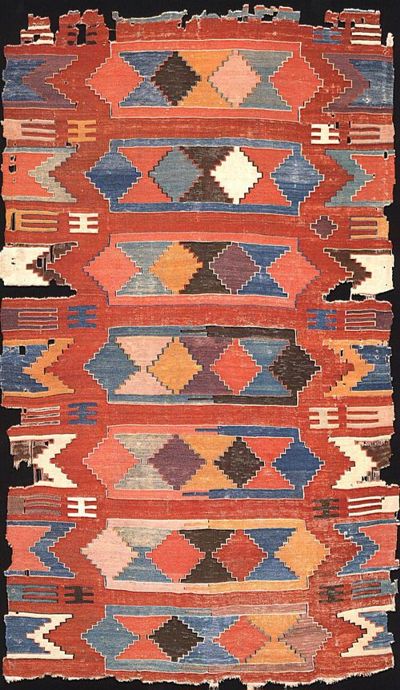

Posted by Chuck Wagner on 10-16-2002 02:41 PM:
Hi Michael,
I'm going to try and elucidate a couple of
thoughts I've had rattling around my head over the last few days, but please
understand up front that I agree with several of your arguments for focusing on
"slow food" rugs. For my part though, I will not describe synthetic dyes as
offensive or ugly purely because they are synthetic. The piece must itself be
genuinely ugly, like that in the first image I posted in this thread. (
 )
)
Having said
that, given two pieces with equal "eye appeal" I will always select one with
natural dyes over one with synthetics, and a genuine "ethnographic" will always
be selected over workshop goods. But as you know, such pieces are NOT often
encountered except in a few auction houses and dealers shops.
Our
collecting criteria are NOT tightly focused. My wife likes city rugs; I prefer
tribals. But we do live together so we collect both. We don't buy a rug unless
we both like it; thus avoiding nasty stares, and comments like: "Well dear, I
actually can't STAND that thing, I just stayed quiet because I thought you
liked it". We try to stick to pieces that we consider unusual compared to what
we've seen in the market or in literature. We try find pieces with better that
average work, design, color balance, etc.
But we will buy the odd wierd
rug; I've posted a few images that should make THAT obvious.
For my
part, when I look at "rustic" carpets, I'll claim I'm looking at a DYING
culture. Anyone who weaves for a living these days is also hoping that their
kids can get an education and go get a real job that pays GOOD money. So
although I try to find the genuine antique tribals, I'll also buy interesting
"newer" production. I guess that our definition of "collection" is different,
and less rigorous, than for some in the rug collection world.
And so, I
have a real problem with this comment:
"My point is: if this is so then
the documents of decay are much less desirable!"
To my mind, use of the
term decay is harshly judgemental. This may well be how you view the transition
from the "old days" to the "new days", and it IS consistent with the criteria
that you have established for collecting, but I do not accept that
change=decay. It's just change.
I do not believe, for a second, that
early 18th century Turkoman carpets designs and methods are unchanged from
earlier Turkoman carpets. The area, and the people, were subjected to
innumerable invasions, displacements, and other cultural pressures. We have
almost no evidence from early times, so who can say for sure. But a quick look
at the Ballard Yomud speaks volumes... Do you not believe that in 1810,
Turkoman grandmothers may well have complained bitterly to their granddaughters
about how the old patterns aren't woven anymore and how "You young people have
no respect for tradition" ?
You may not LIKE the change to synthetics;
that's fair. But the new stuff is just part of an evolving record of an
evolving culture. That doesn't make it good or bad, just different. I don't
want to try to change YOUR mind about YOUR collection criteria; I accept that
they're well thought through and, not unreasonable. But woven goods are still
being made for personal use, and they're still showing up on the
market.
Which gets me to the other thought, which really is still an
open question: Can knowledge and/or classification of synthetic dyestuffs
contribute to estimation of provenance, or ethnographic attribution, of more
recent (20th century) weavings ?
During this discussion we have from
time to time touched on this question, and truthfully, I'm not sure that
there's a nice structured answer. But a century from now (see John's Salon)
people will look back and note that chrome dyes were in heavy use up to about
1965-1970 and then began to phase out in favor of dyes without heavy metals.
Someday, they will be a marker in time for future collectors.
This has
been a very stimulating session, and I thank you (and everyone else) for taking
the time and effort to keep at it. At this point, I'm starting to have trouble
keeping track of what we've already discussed when I write new posts. I think
that may be a sign that we're wearing holes in the pile of this topic. I hope
that's what it is, otherwise it might be a degenerative neural disorder, such
as:
getting older...
Regards,
Chuck
__________________
Chuck
Wagner
Posted by Michael Bischof on 10-17-2002 04:03
PM:
Hi everybody, hi Chuck,
with these kilims I
wanted to demonstrate quality differences between natural dyes at the level of
two quite early pieces. (of course you should here look into - the Rageth book
on radiocarbon dating of kilims for the first piece - the McCoy-Jones catalogue
of the kilim exhibition that paralleled the ICOC in San Francisco for the
second piece)
The first piece is quite older. Most of its dyes are quite
perfect professional dyes. A lot of "minor shades" are, according to my guess,
professional as well but lighter. These suffered more from light oxidation
first and finally by not appropriate washing which apparently has removed quite
some of those latter dyes. As a result the once wonderful colour harmony
suffered a lot (the kilim is still one of the most important early flatweaves
from its region). The second piece is from the same region but younger and has
much less saturated dyes (the bright yellow is excellent, though). Fading
enhanced the abrash a lot, so much that the difference between the abrash and
some motive details done once with less good dyes is unclear now in some parts.
Result: even at that early time they cooked (dyed) with water only.
For
me age is not a merit in its own! I am a biologist. When the evolution creates
new forms at the beginning, in a kind of trial-and-error phase, a lot is
"crude", a successful solution not yet found. Similar I see the development of
arts.
"But woven goods are still being made for personal use, and
they're still showing up on the market."
Yes, but unfortunately this is
a kind of waste market - overflooded with pieces from people that leave the
countryside and flee into the cities. So any kind of grading, which is
essential for keeping up quality, together with a fair price, is lost. As a
matter of fact the extreme small number of educated
customers is the biggest bottleneck on todays markets. It creates a kind of
"stupid demand", people who can be fooled too easy with fairy tales of faded
"soft" natural dyes in the touristic centres, from Istanbul over Rajasthan to
Chiang Mai...
"I guess that our definition of "collection" is
different, and less rigorous, than for some in the rug collection
world."
I share you point of view. But those collectors who cannot
merit creative successful new weaves are the mediocre types anyway - the real
leading guys are different. "Age" alone as a quality mark is a stupid idea and
they know that.
Look at the
yastik adventure of R. John Howe where the youngest piece
has the best graphic and where on can learn that weavers may borrow alien
designs without success in antique times. So those "rigorous" people
are, in my opinion, the kind of "unsafe middle" people who stick to age as they
have nothing more developed to found their measurements. A kind of desparate
cry in a situation where they feel a lack of "safe" measures. They can't do
better than "age".
"Which gets me to the other thought, which really
is still an open question: Can knowledge and/or classification of synthetic
dyestuffs contribute to estimation of provenance, or ethnographic attribution,
of more recent (20th century) weavings ?"
I fear the answer is "no".
Too much is disturbed and mixed by the cottage industry in traditional weaving
areas.The only chance you might have is to live (!) in such a place and learn
to know from close distance the different styles they do there - by the way:
that would produce the desired ethnographical background about which
many people only talk.
"...but I do not accept that
change=decay. It's just change." and "I do not believe, for a second,
that early 18th century Turkoman carpets designs and methods are unchanged from
earlier Turkoman carpets."
This I did not say. I said: change may be
decay. A broader perspective: in the 16th century the silk road as a fertile
exchange area stopped to exist. People there had lived in the centre of the
civilized world - and out of a sudden they were stuck in a forgotten corner of
trade, geography and of cultural development. Stagnation and starvation - in
the 19th century they fell victim to the Russians with ease. I am very curious
to learn how Turcoman material before this turn looked alike.
I can
respect the technical quality of early Turcomans and their talent of combining
very saturated dyes of middle quality to create admirable effects. On the other
hand: "you see one - you have seen all" ... result of this stagnation, boring
repetititon, may be with the exception of some exciting 19th century Ersari
material where they tried to "digest" external stimulus' in a creative way. -
Technically and aesthetically the transition to synthetic dyes for me is a
decay as they did not change
the motives and the colour style, but
they changes the dyes! So they did not evolve. Creative developments at his
particular time will most likely not happen there as they did not recover any
kind of cultural self respect. Look at Turkmenistan of today! Must I say more?
This is not the environment for a creative evolution. Cultures must live.
"Living tradition" is, for me, a stupid marketing story of touristic souvenir
shops. If people copy themselves, their own tradition, without thinking
further
this culture has died.
Another interesting illustration I
today prepared for a salon discussion here on Turkotek that will come soon. I
came to the conclusion that with pile rugs some 13th century material is, in
certain aspects, less good, less evolved, less sophisticated than 15-17th
century material. With my "evolution perspective" in mind I do not admire
anything just for its great age. I saw once the oldest known flatweave ....
extreme rare, extreme old, extreme insignificant and ugly. A little Mickey
Mouse rug done by a motivated and talented weaver (of course with synthetic
dyes! A must!) would be artistically most likely much better.
The best
illustration for what I want to say is, may be, the evolution (and the decay)
of Navajo weaving. The oldest weaves are by far not the best ones. It had a
climax (artistically, though they worked with foreign dyes!) and a decay after
they lost their independance as a nation. And opposite to what had happened in
the Orient it is well documented - as they had been "our" enemies for some
time.
Today we support some gifted individual weavers in Central
Anatolia - of course working with natural dyes as they are rooted
in that
culture and work with these motives and their "indigenous" style of combining
colours. We have a close look on some Turcoman weavers that came to the Konya
area as refugees and who did not stop to weave. Very interesting observations
that go beyond the aim of this particular
thread!
Greetings,
Michael








































 )
)